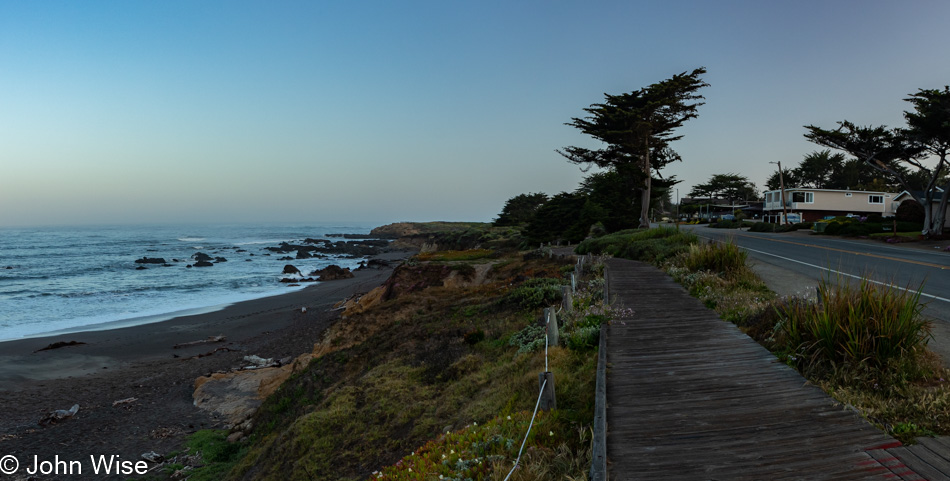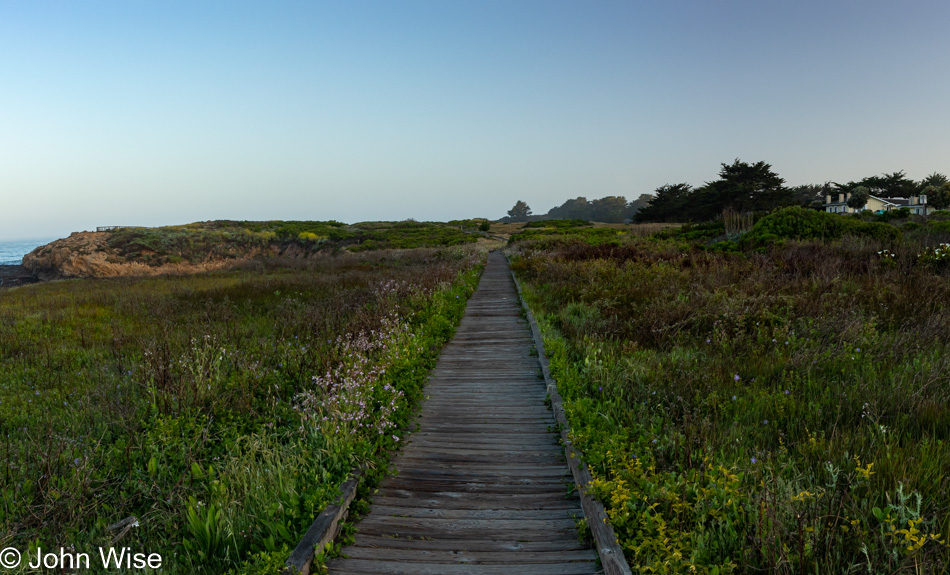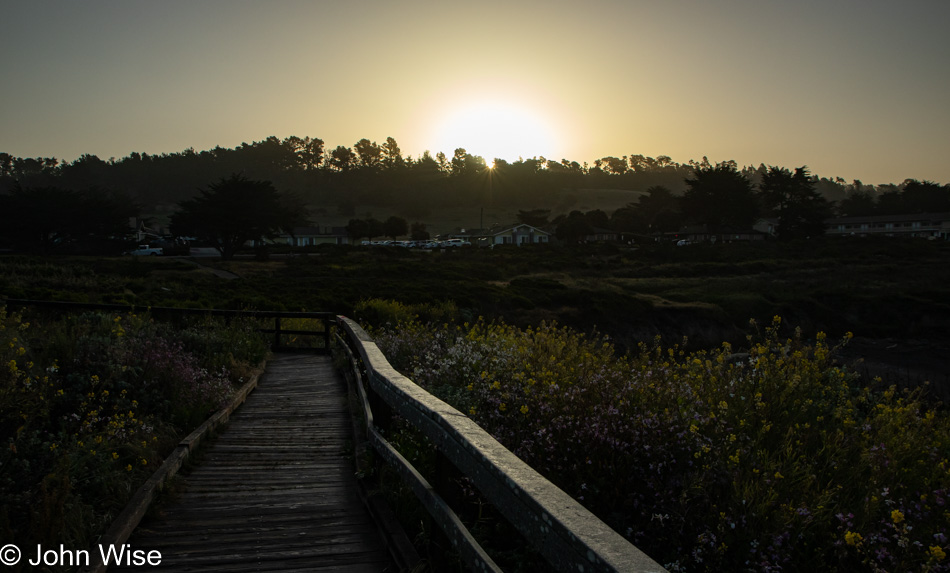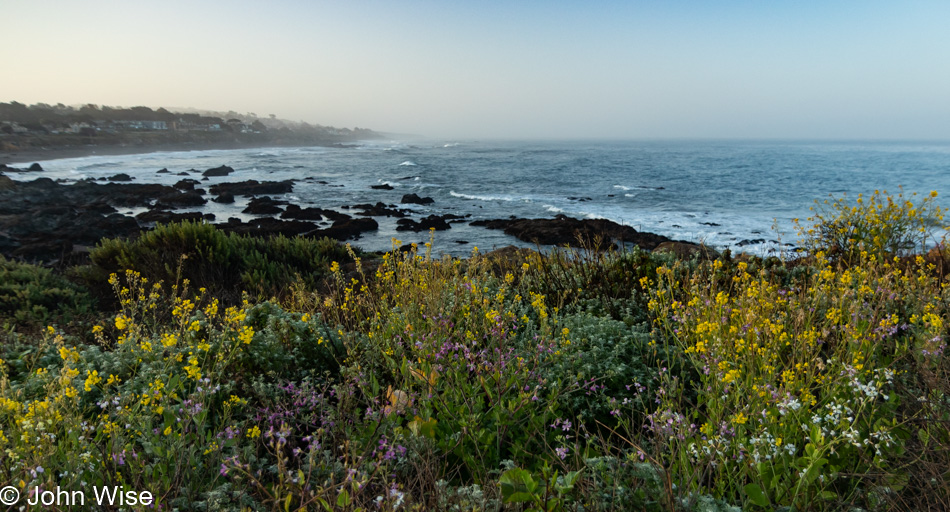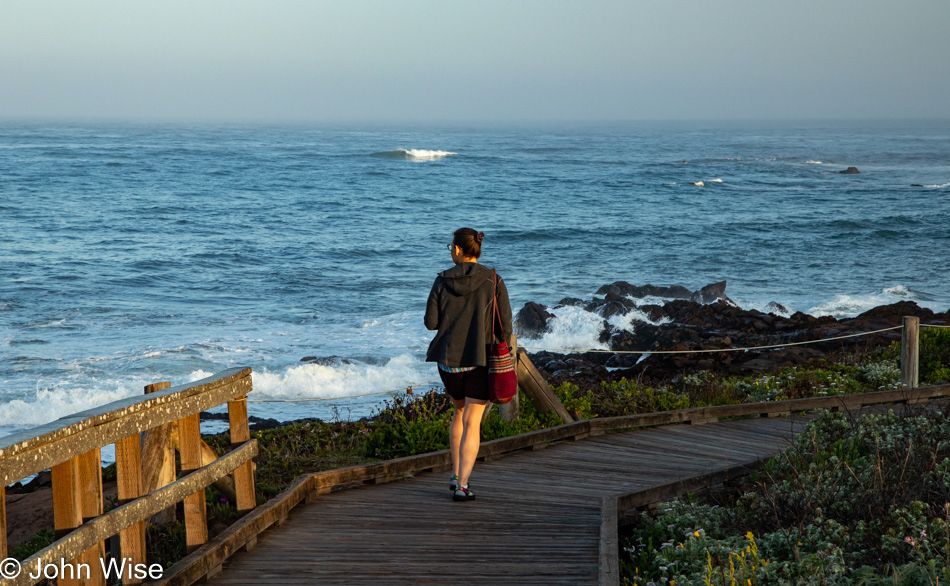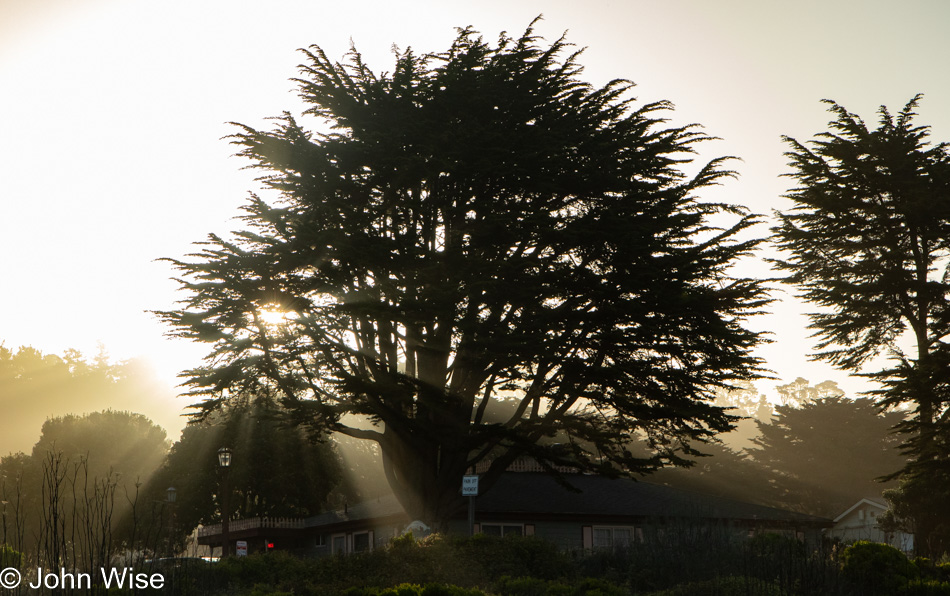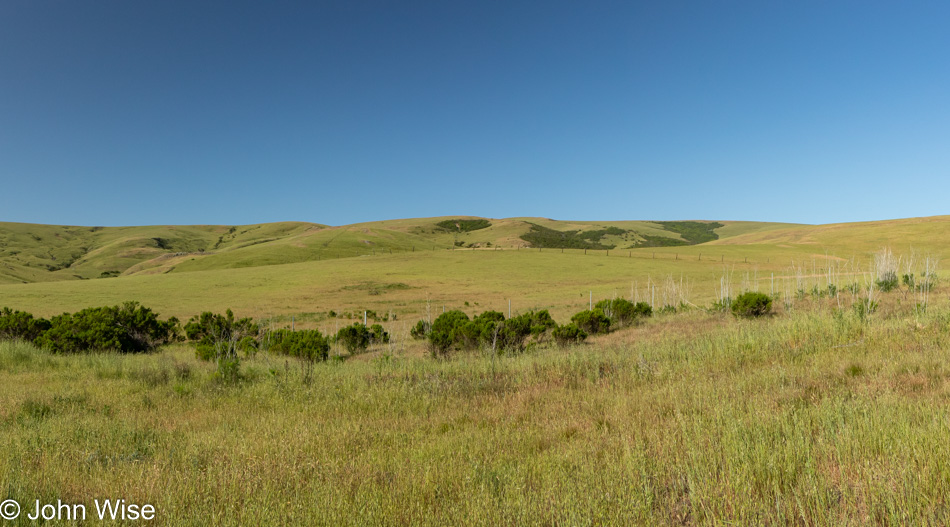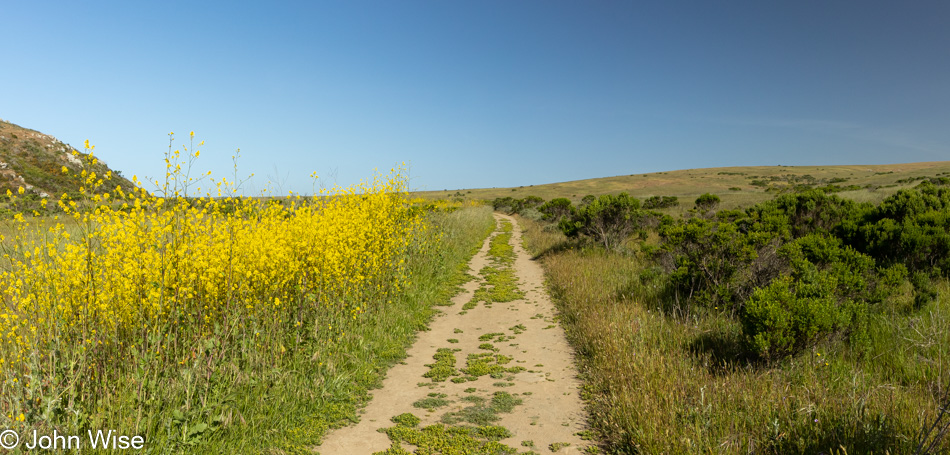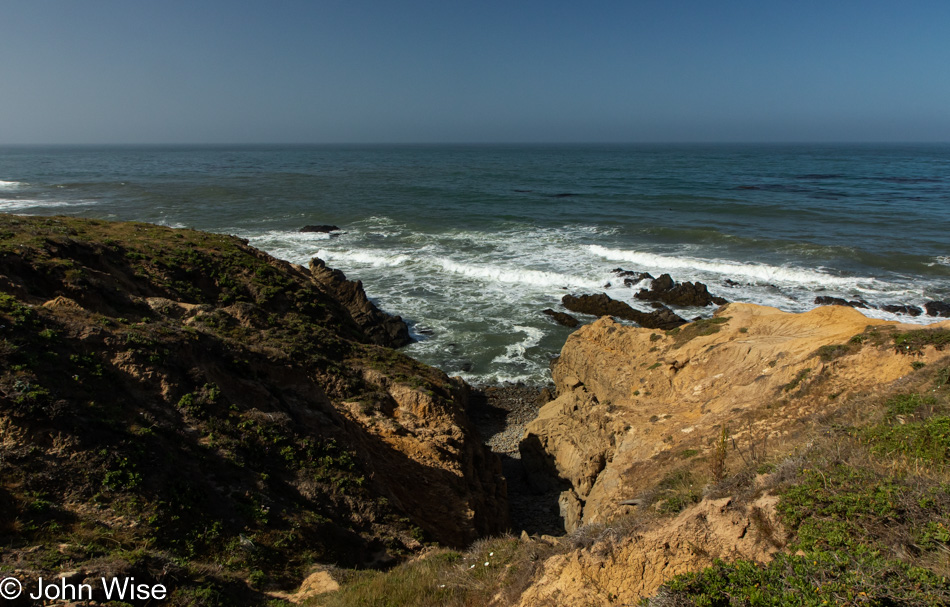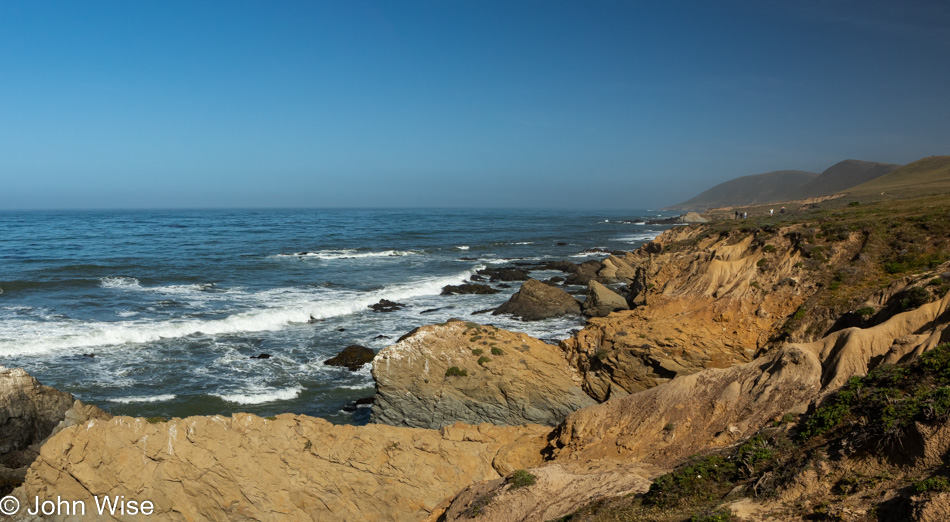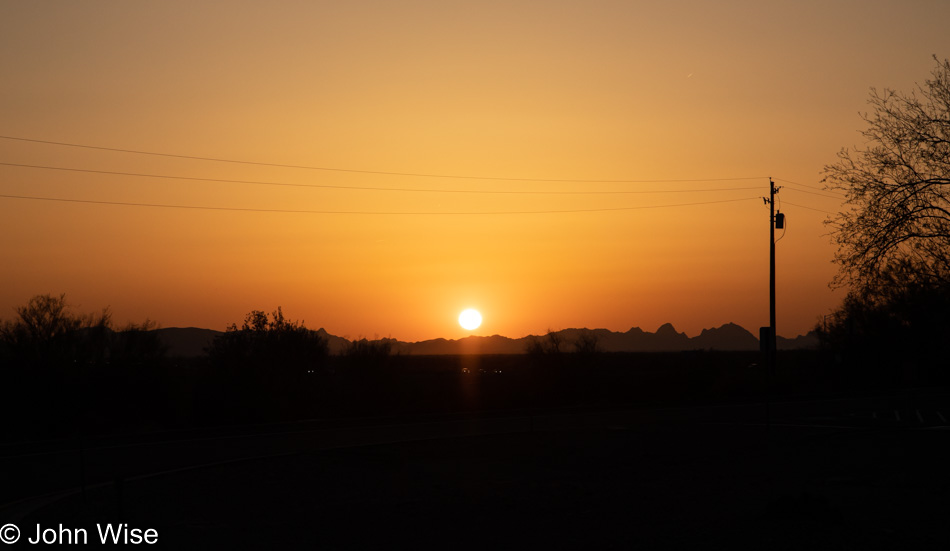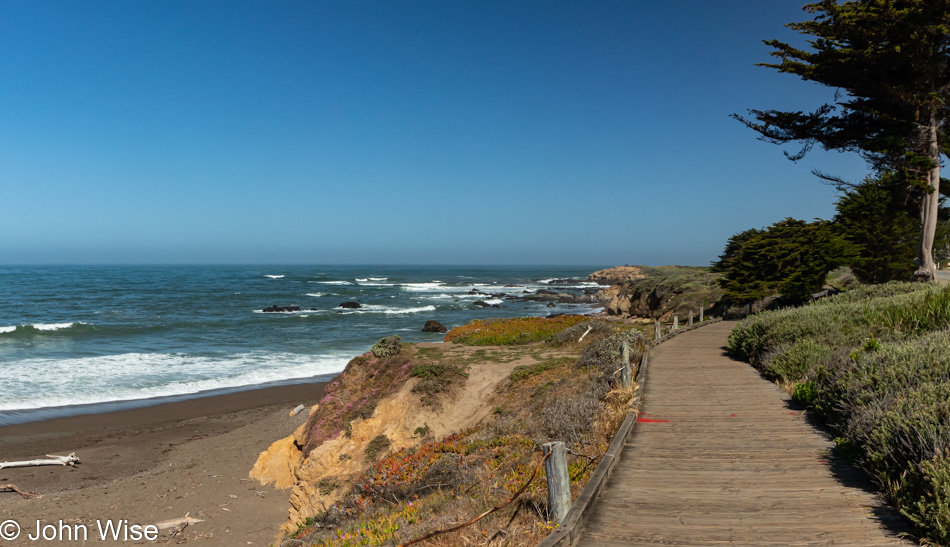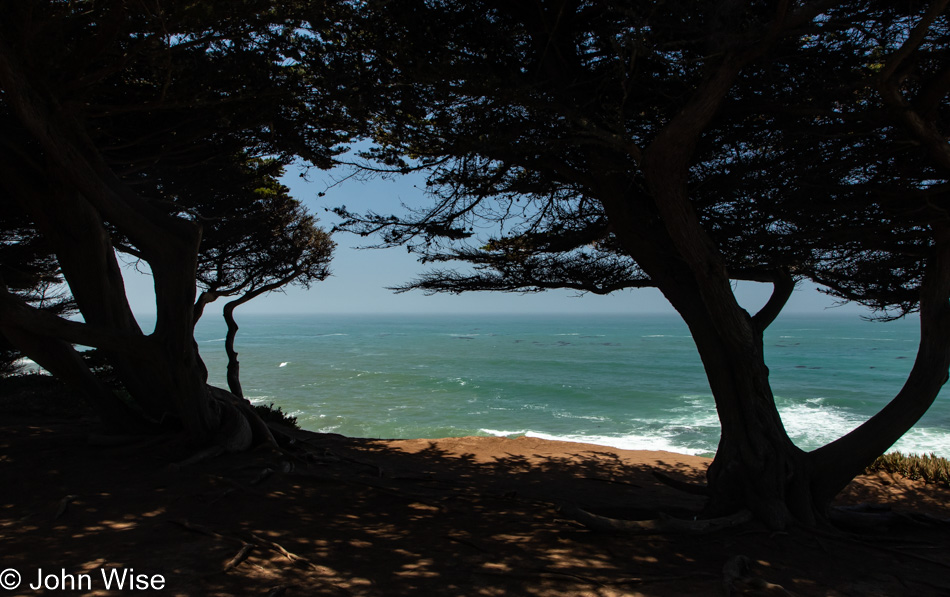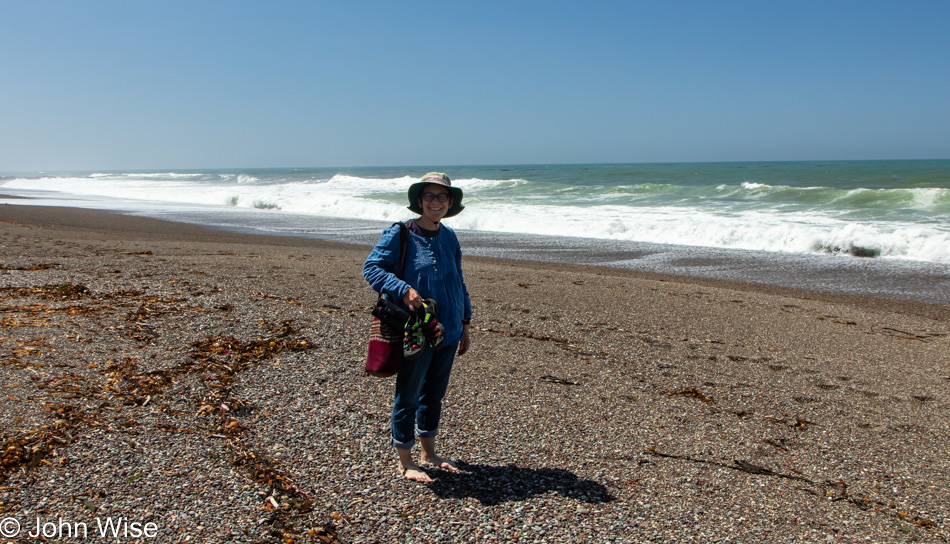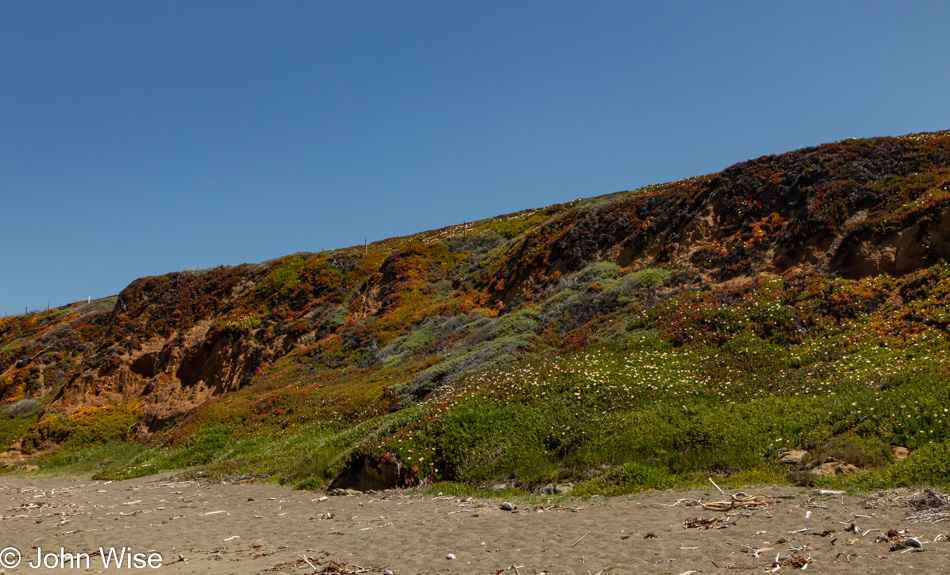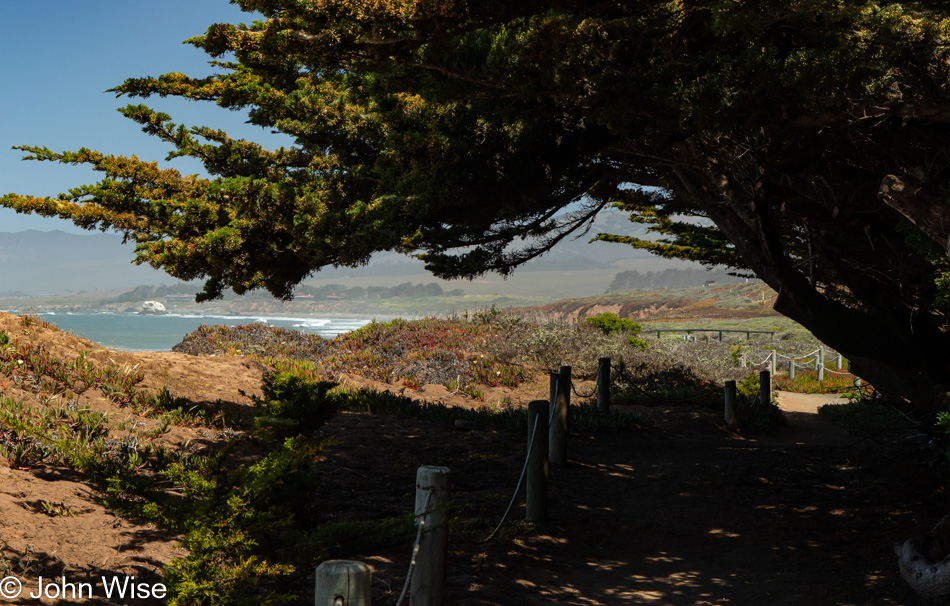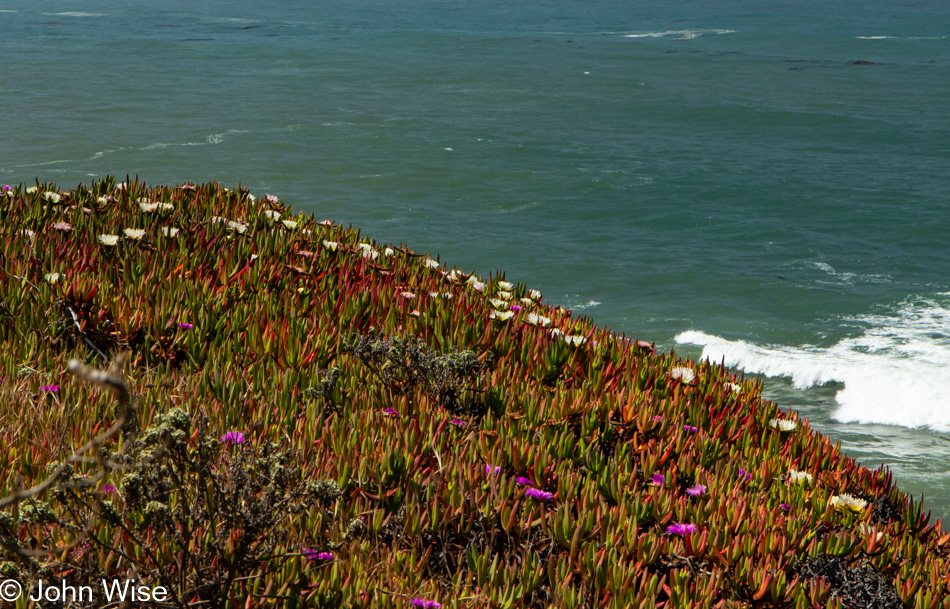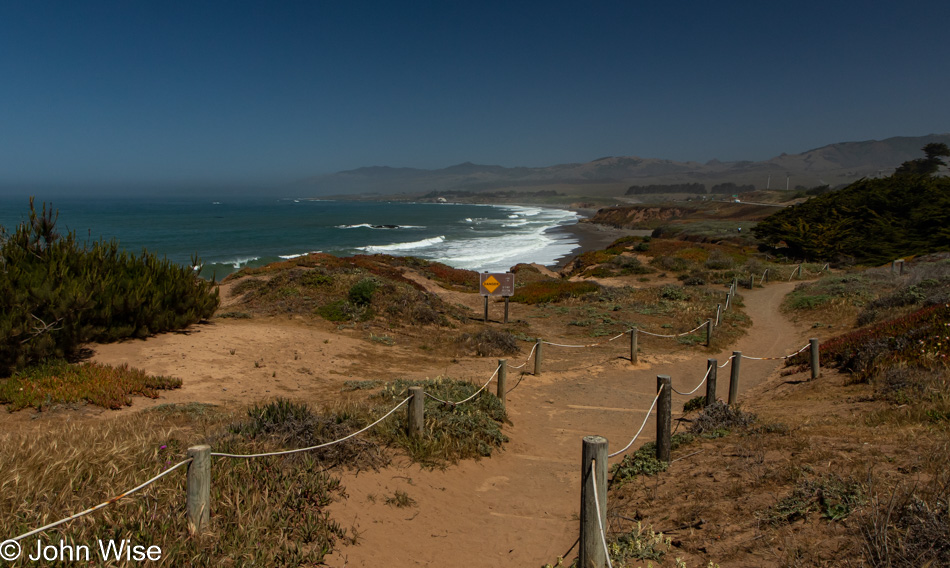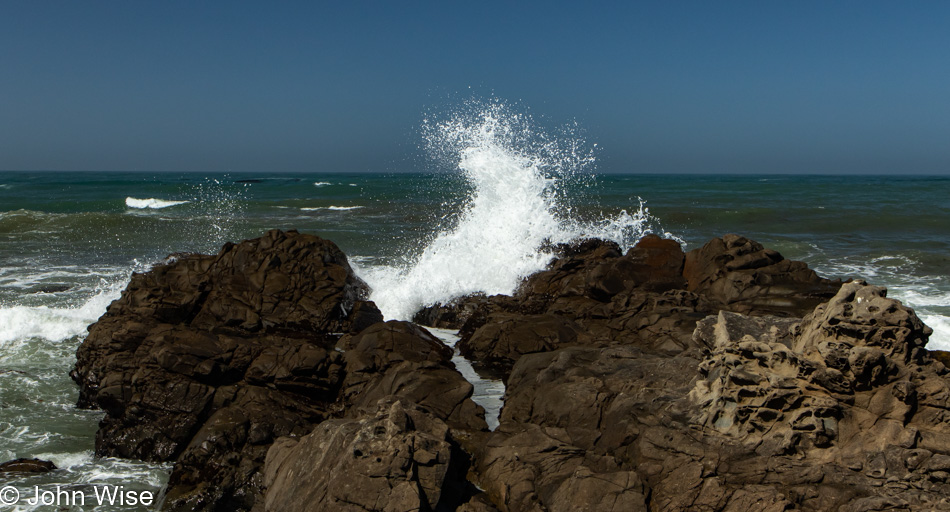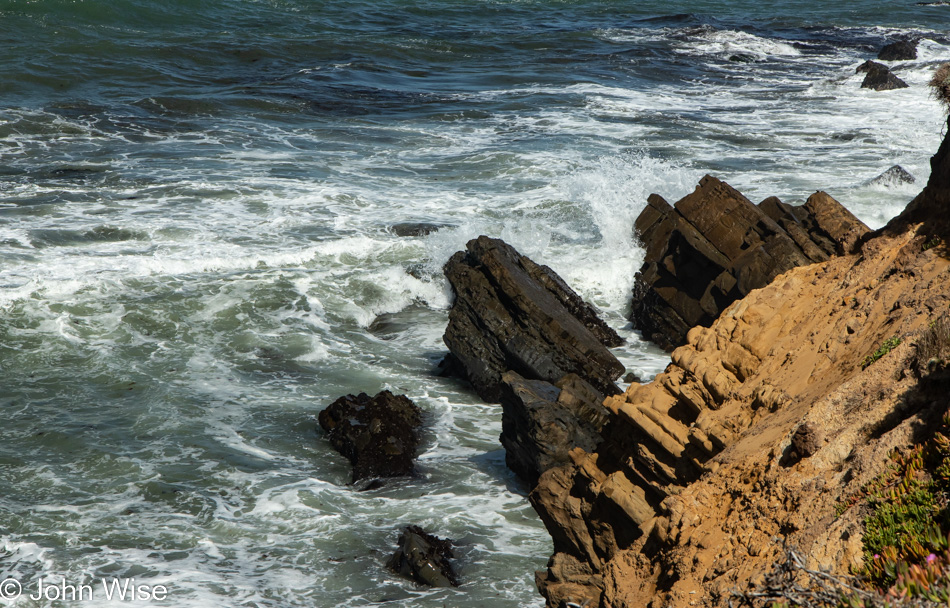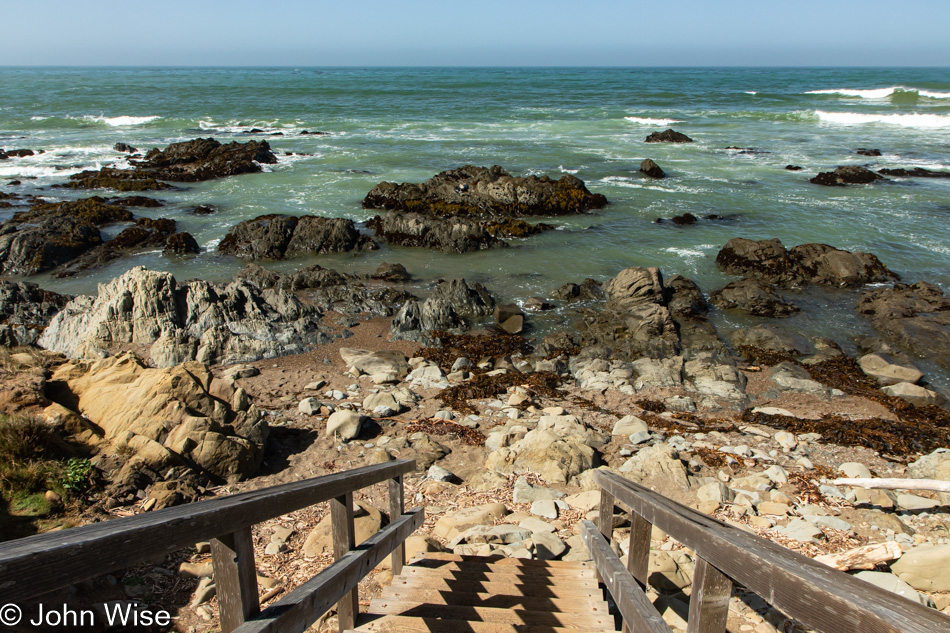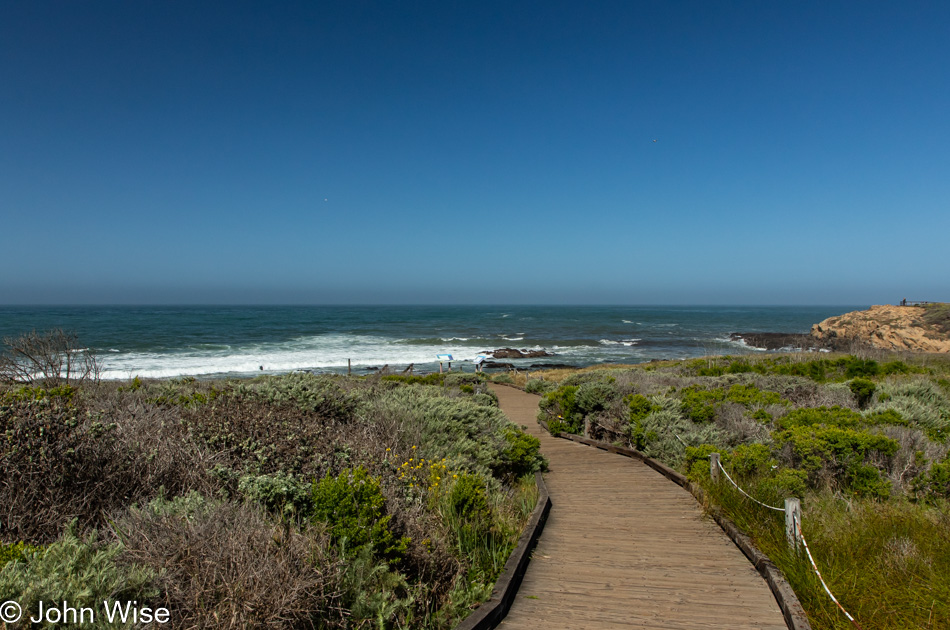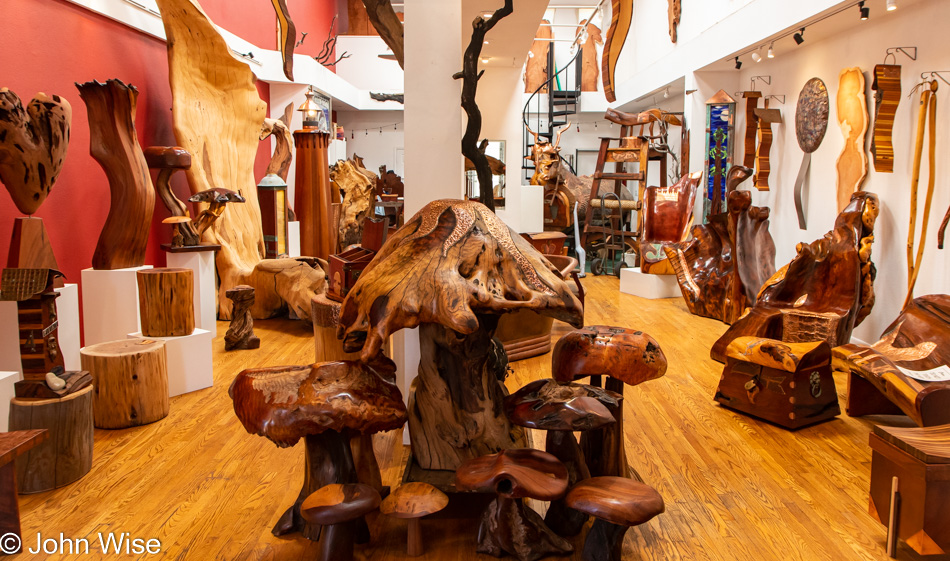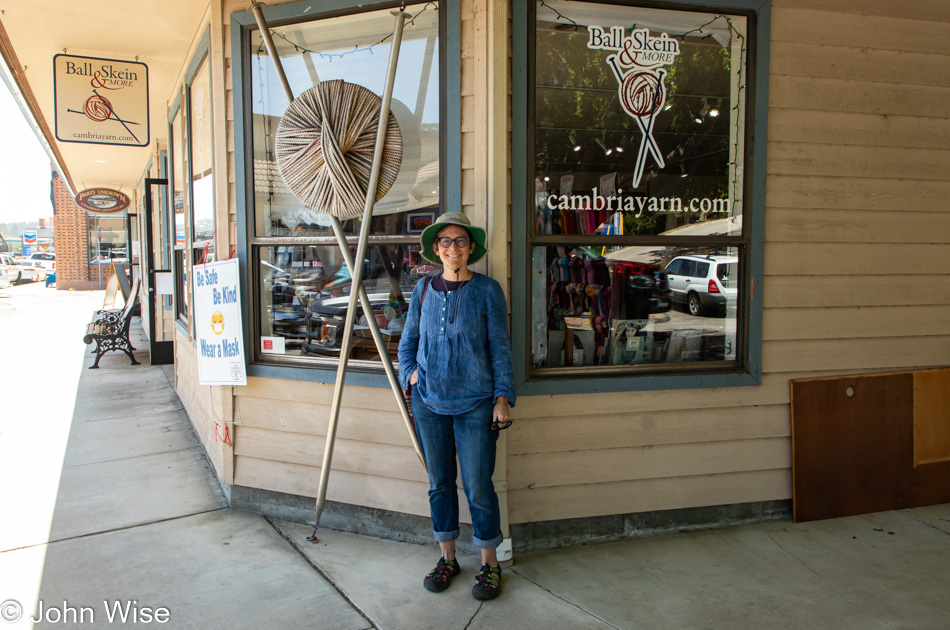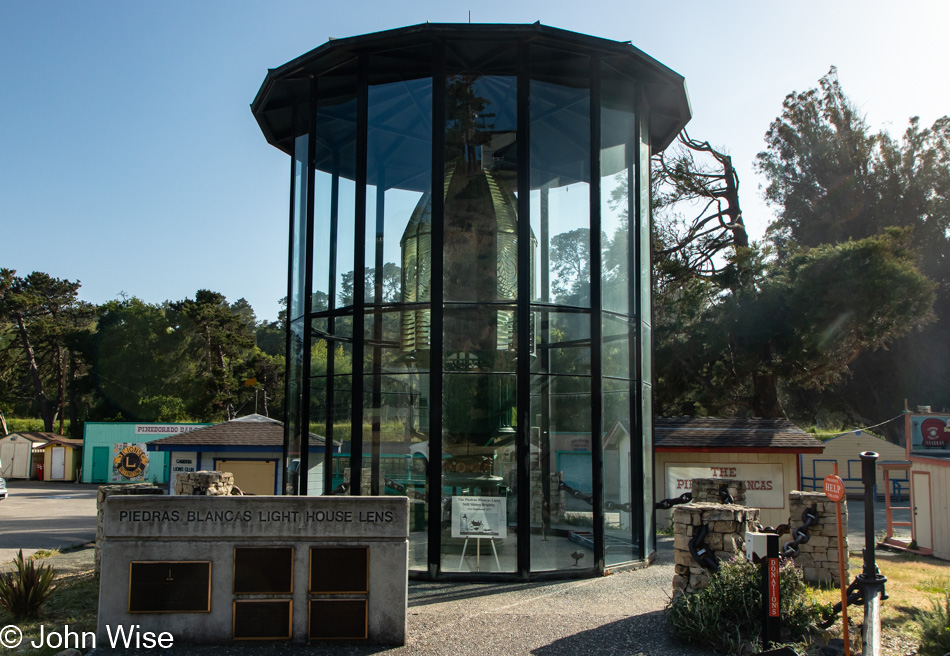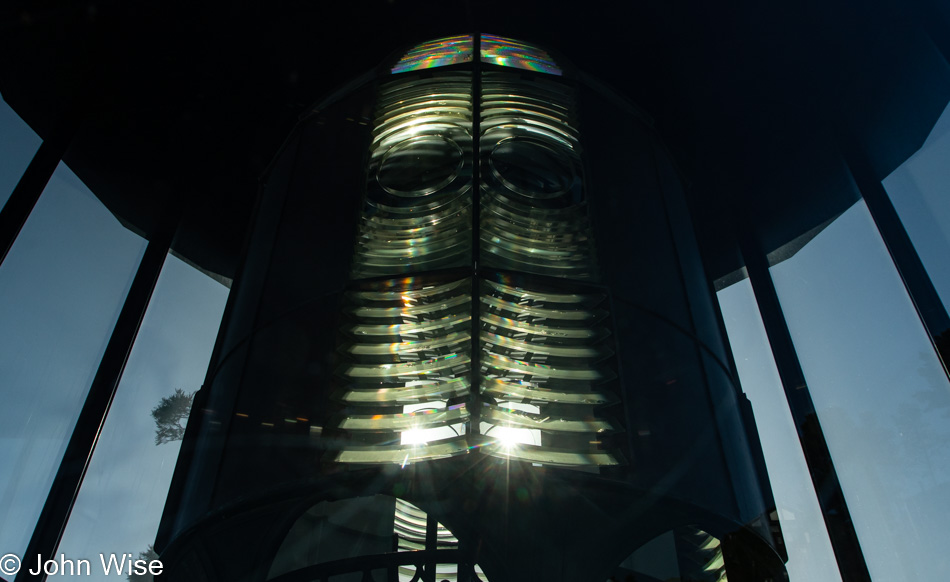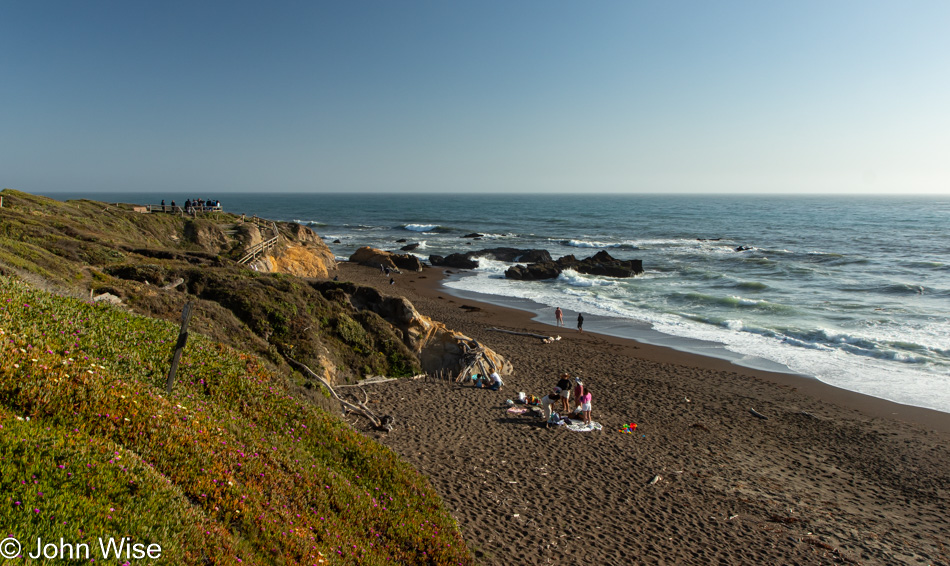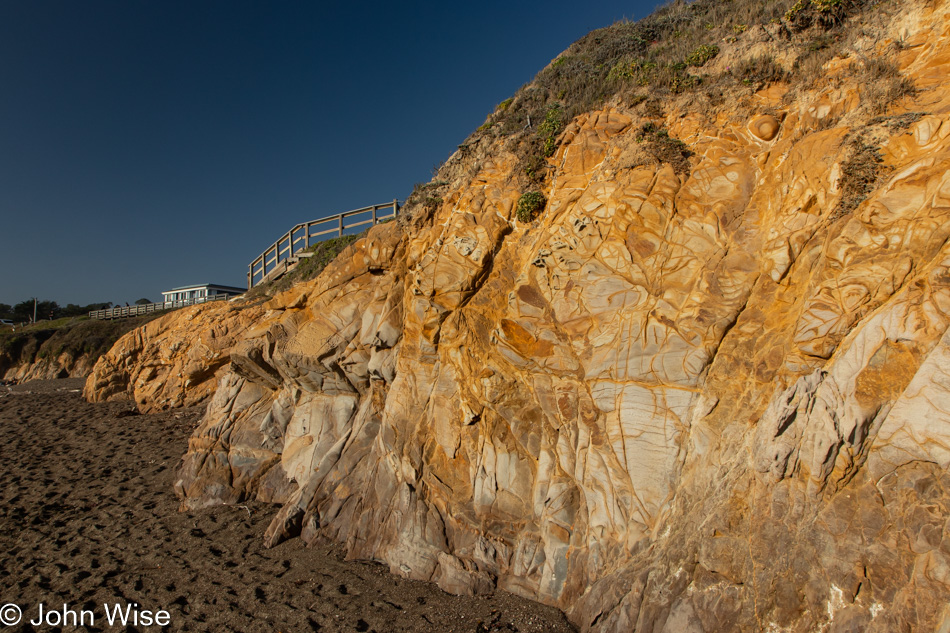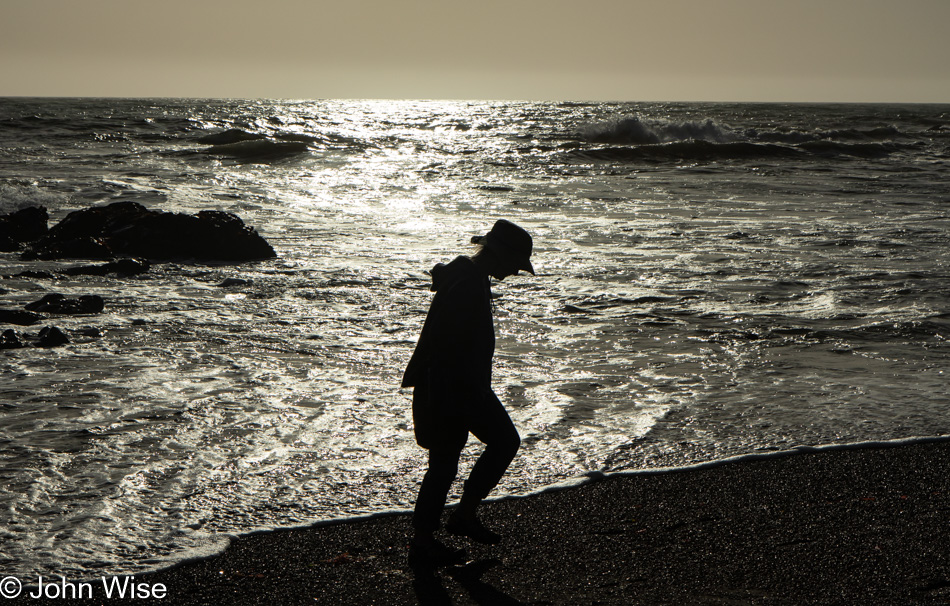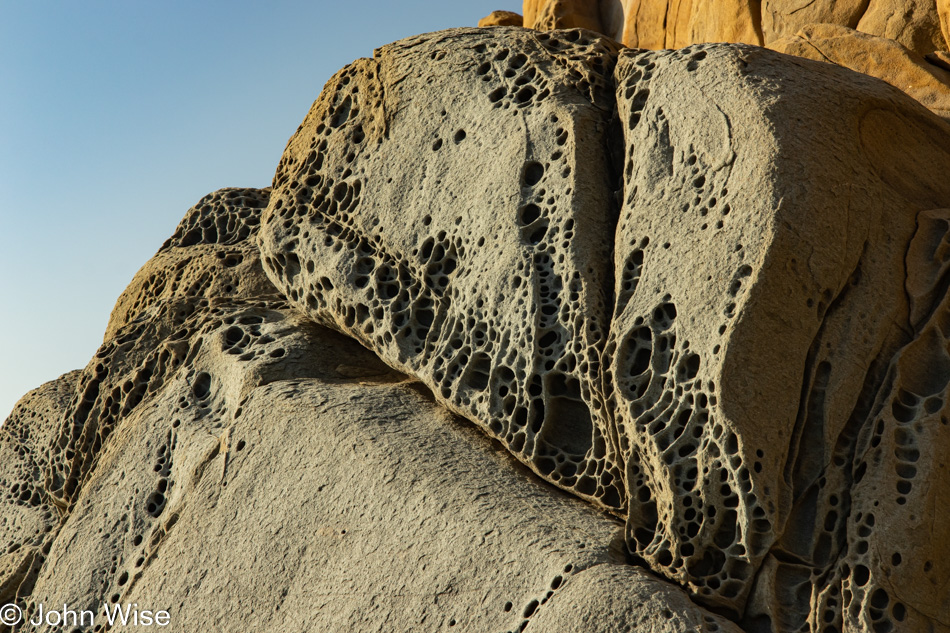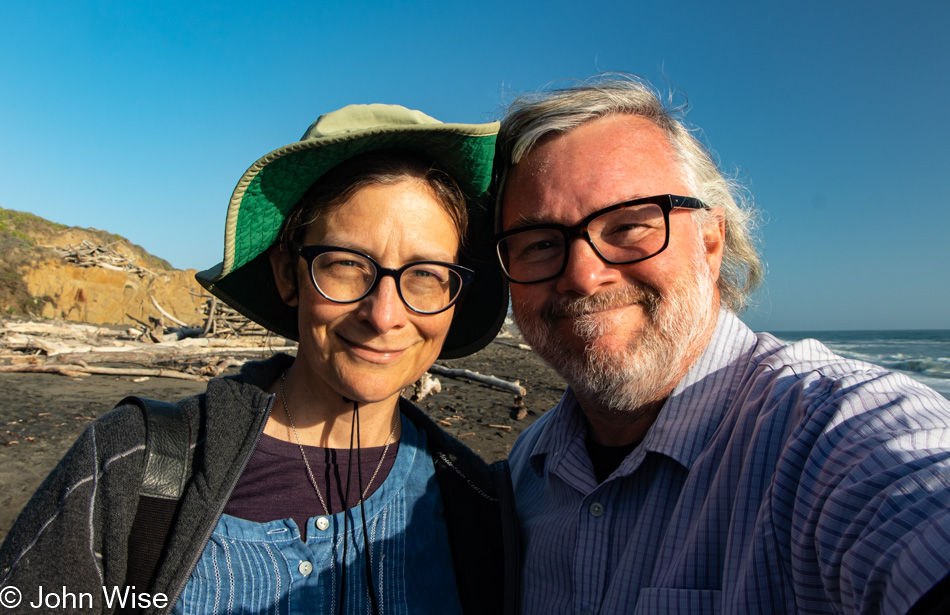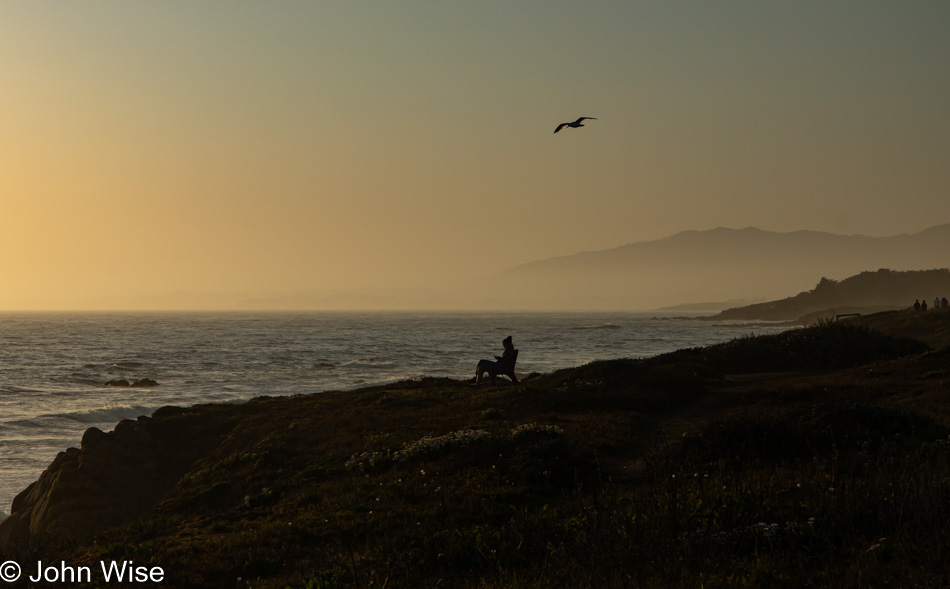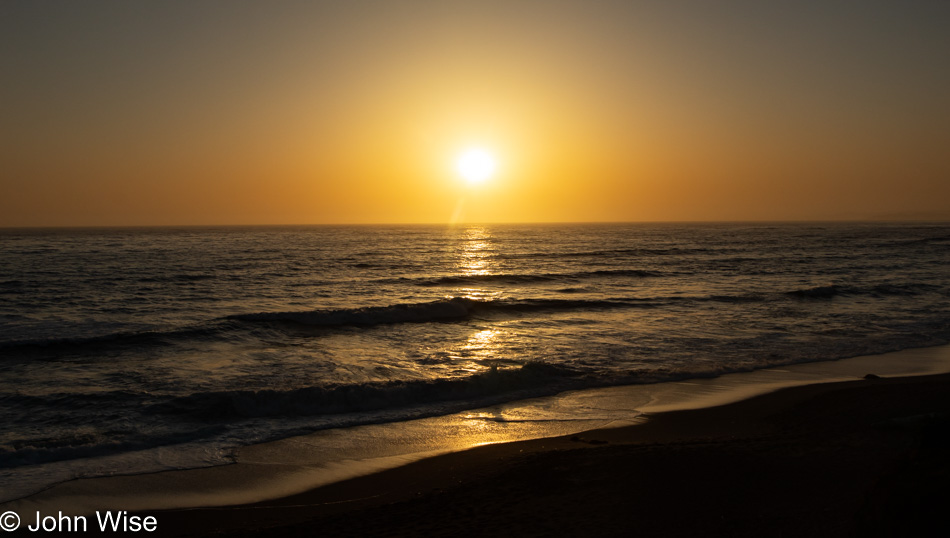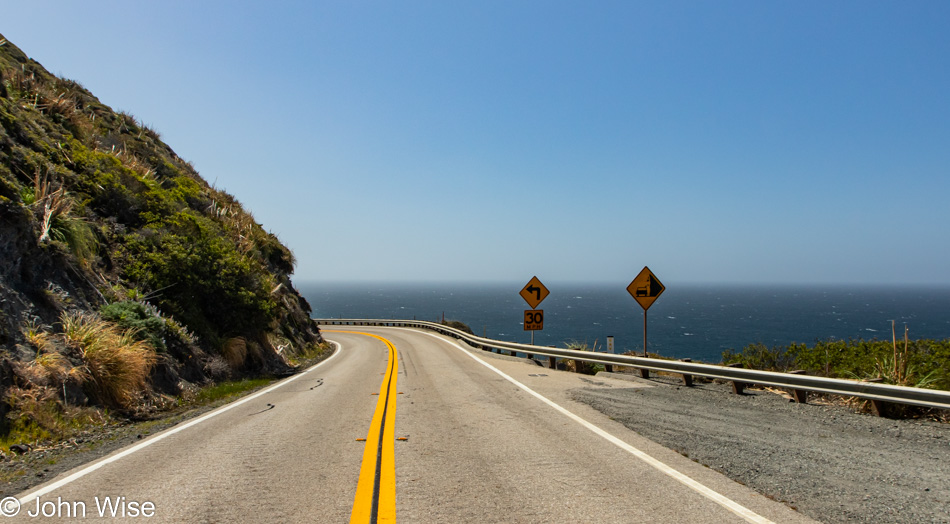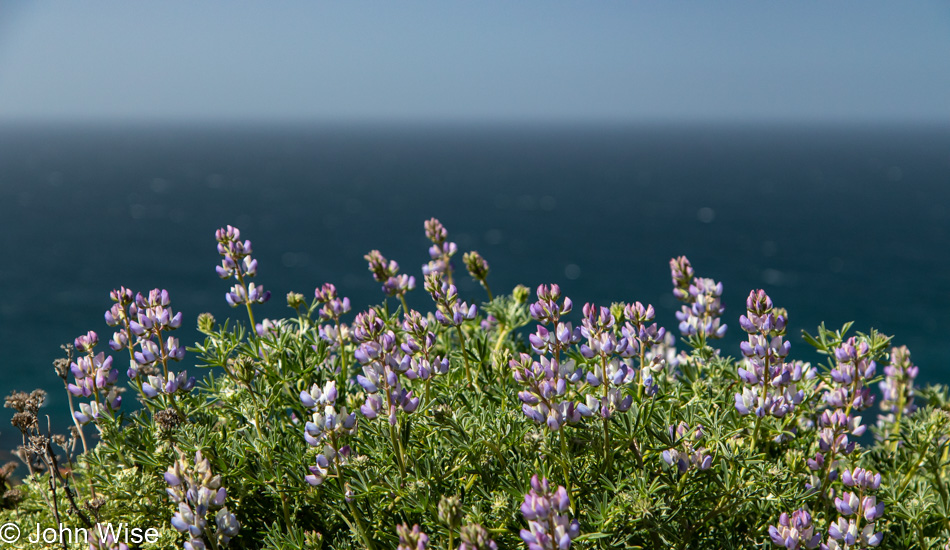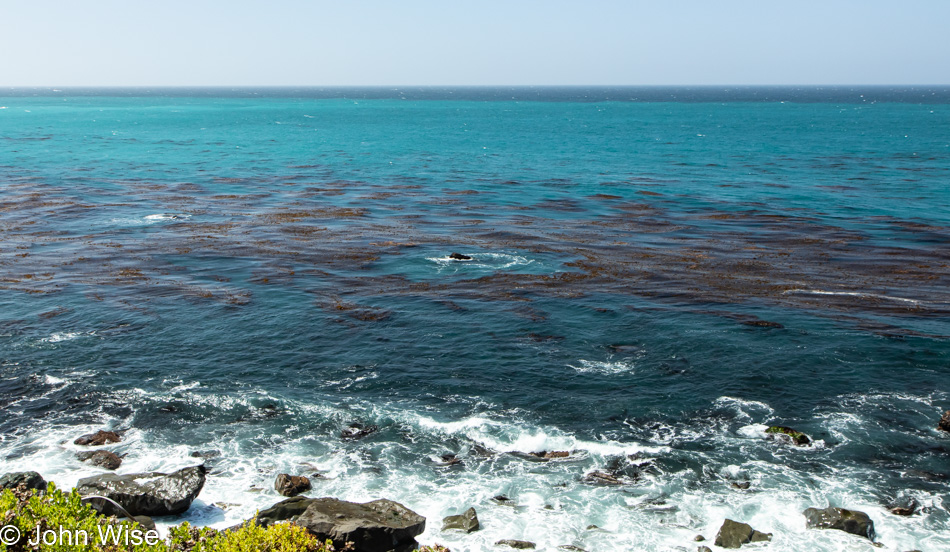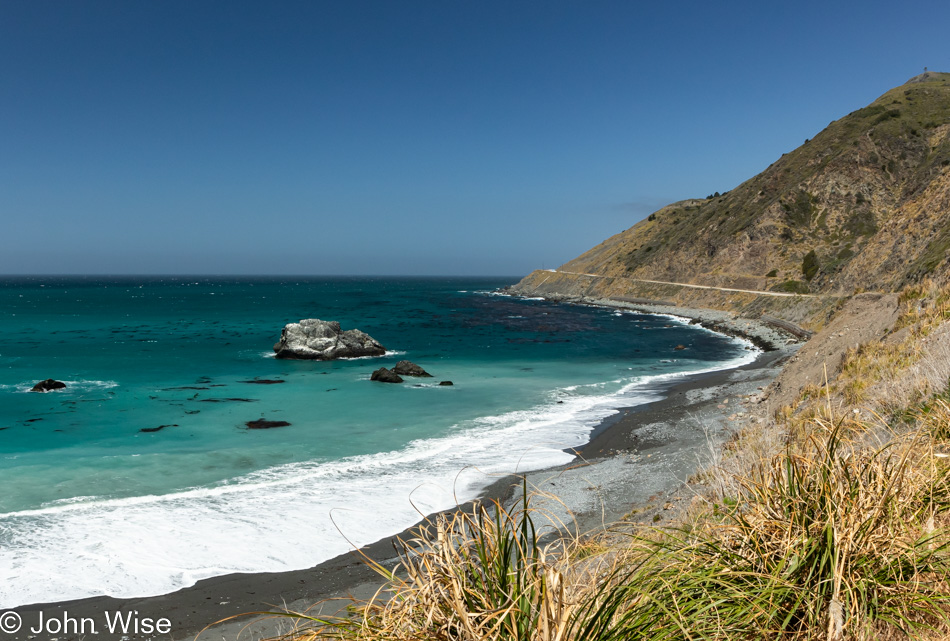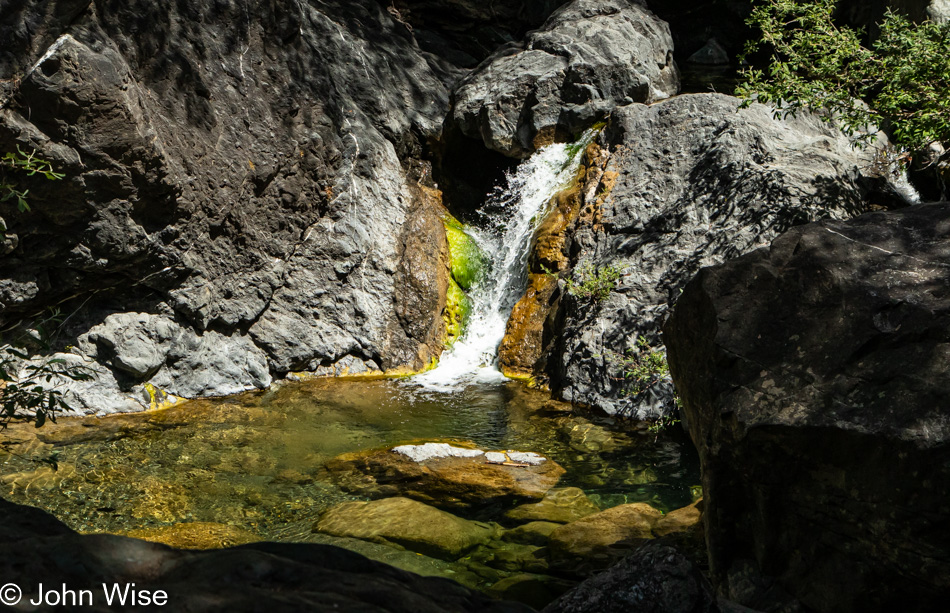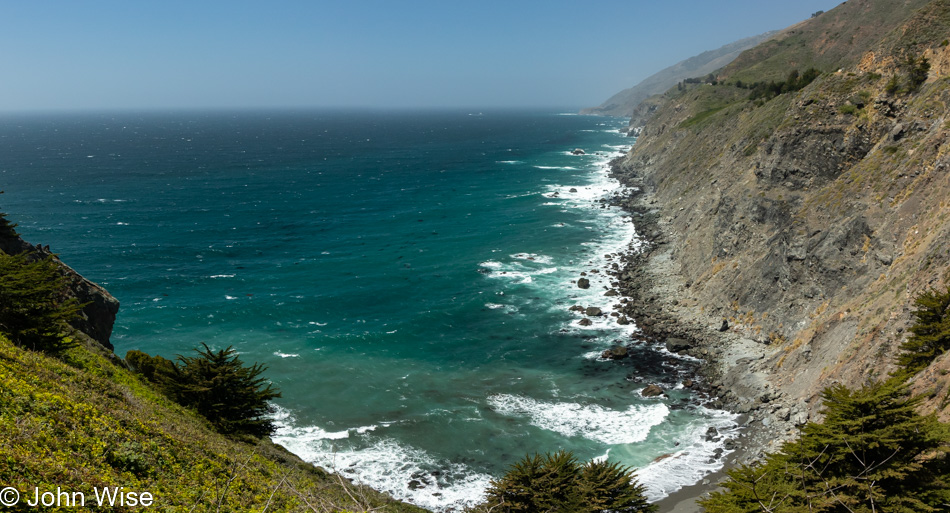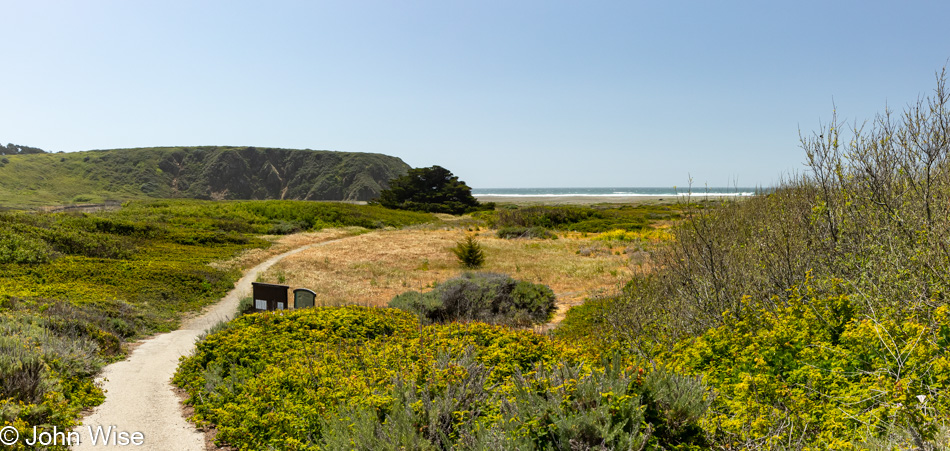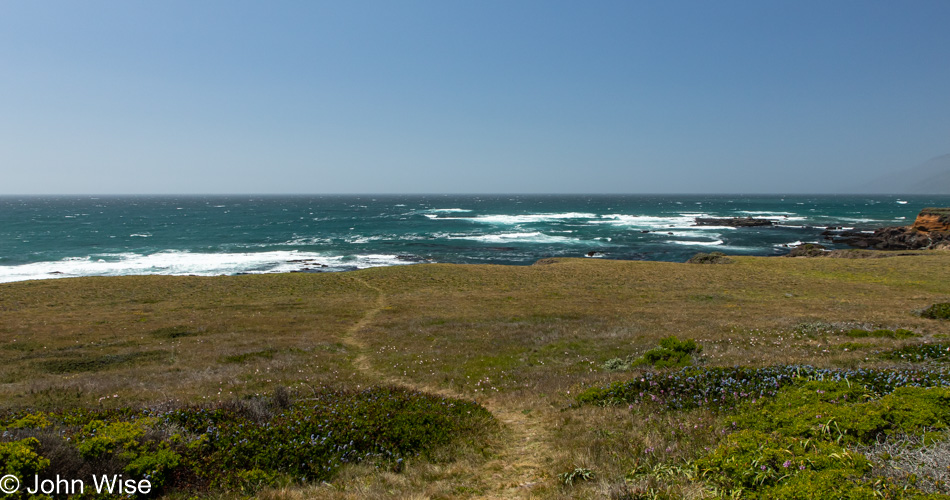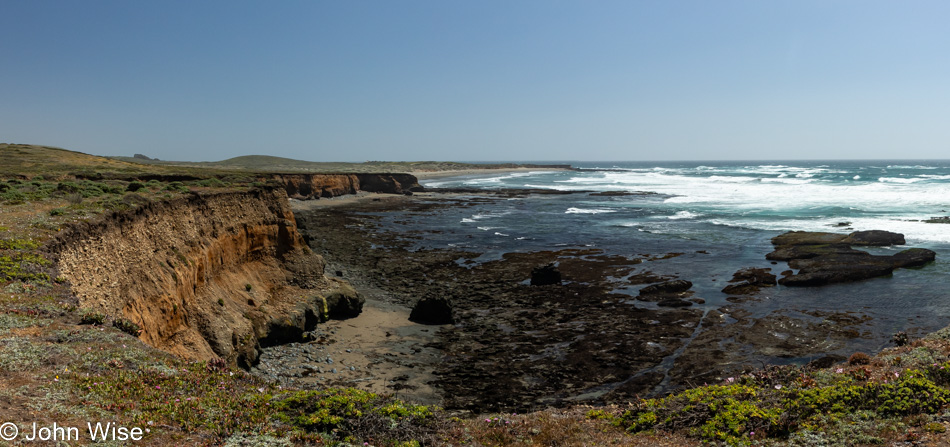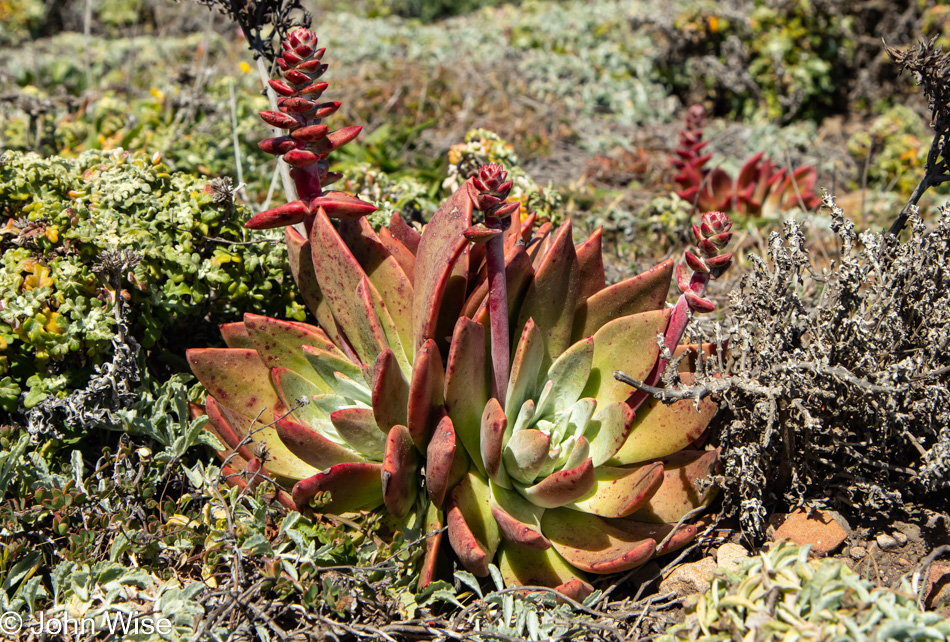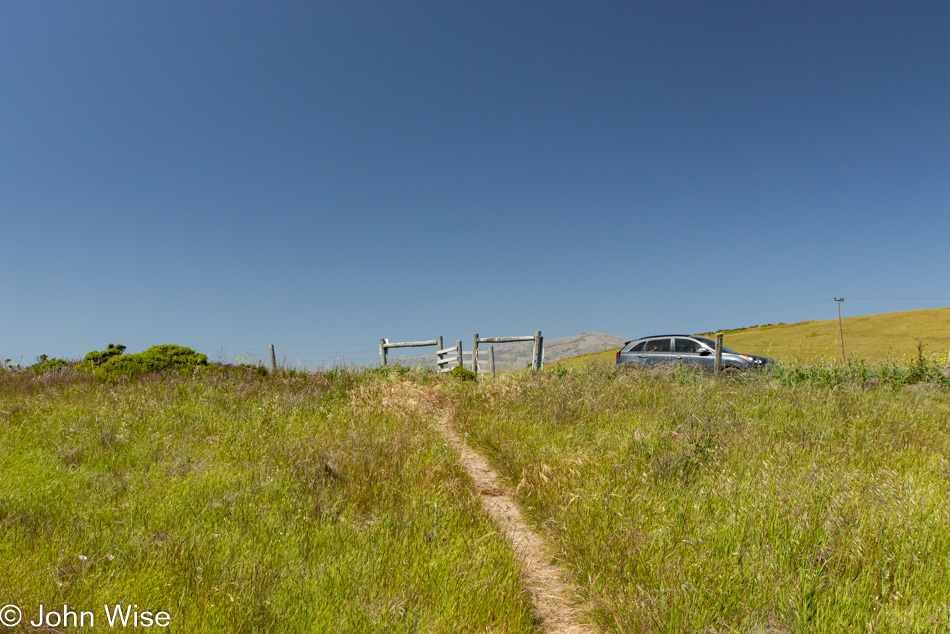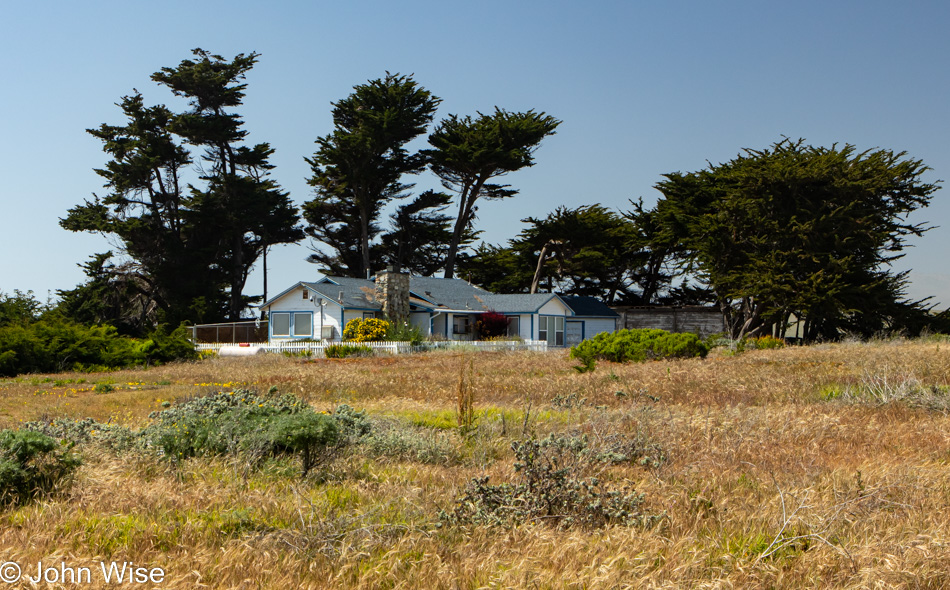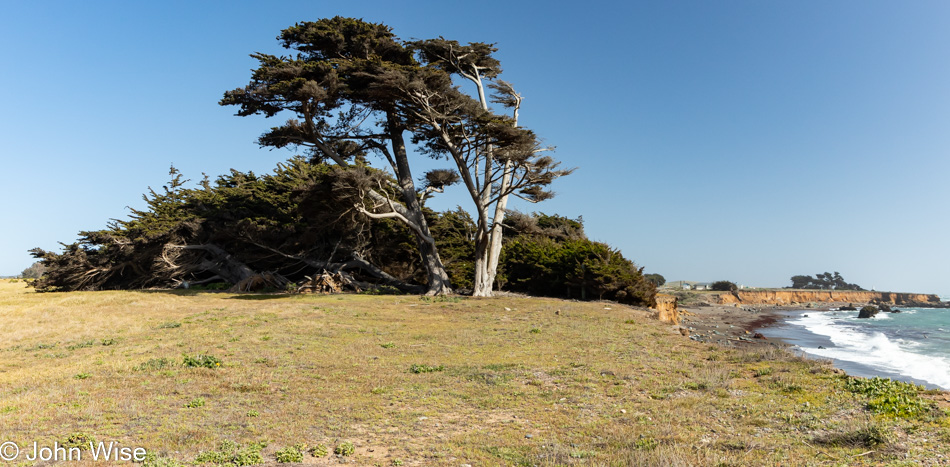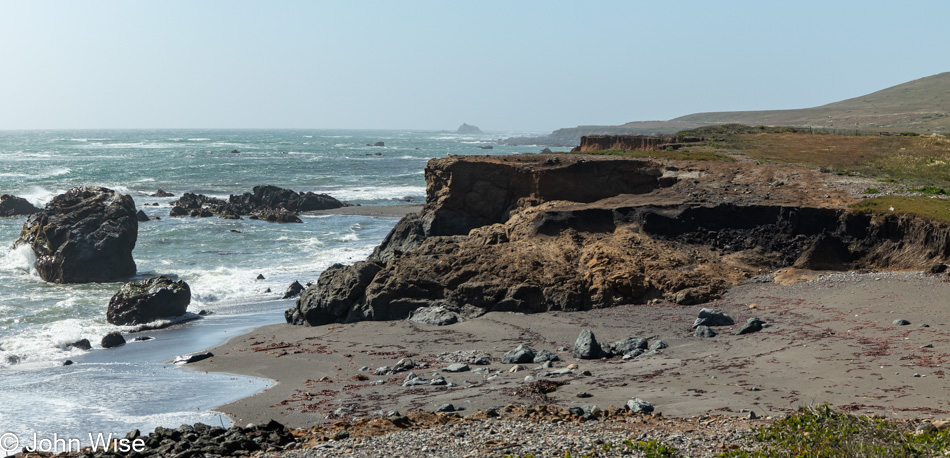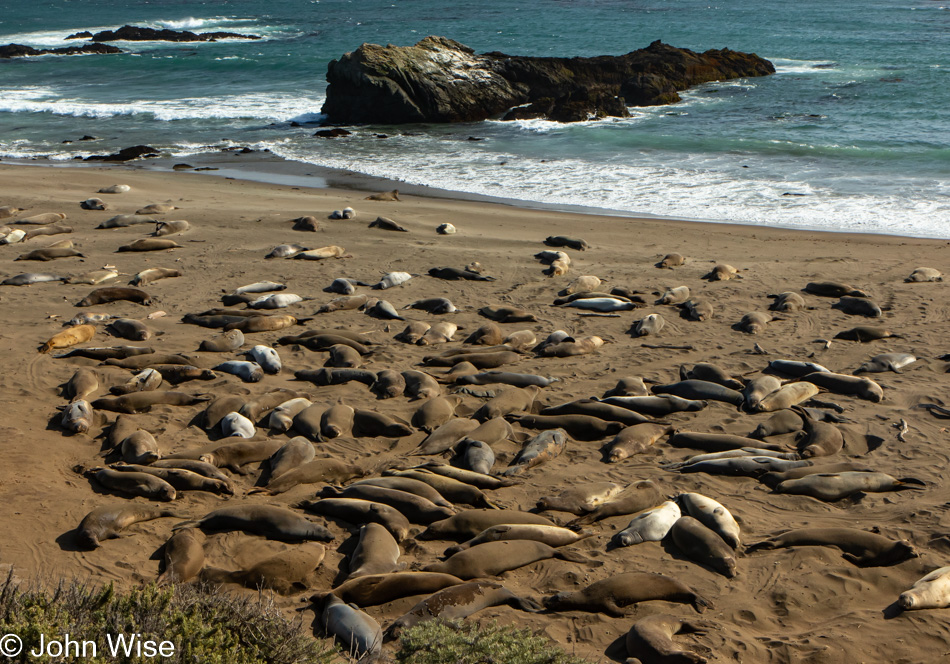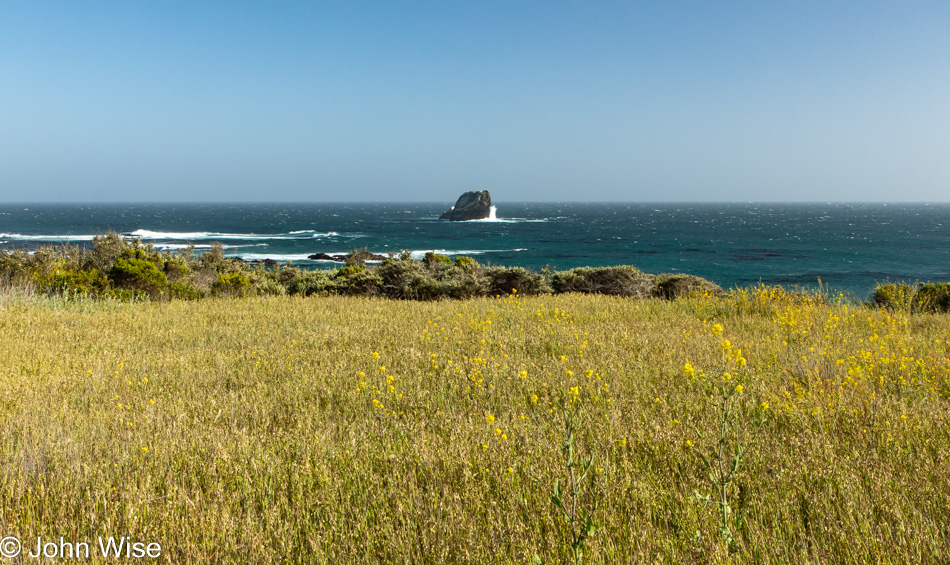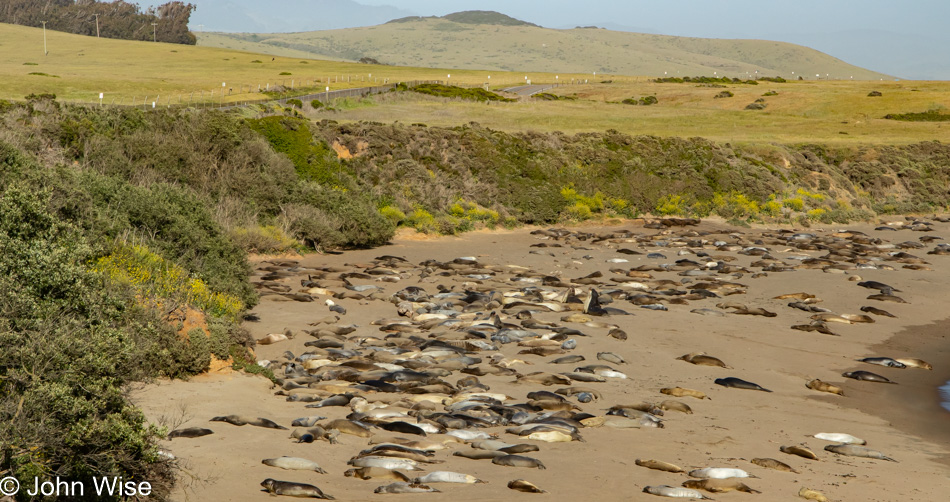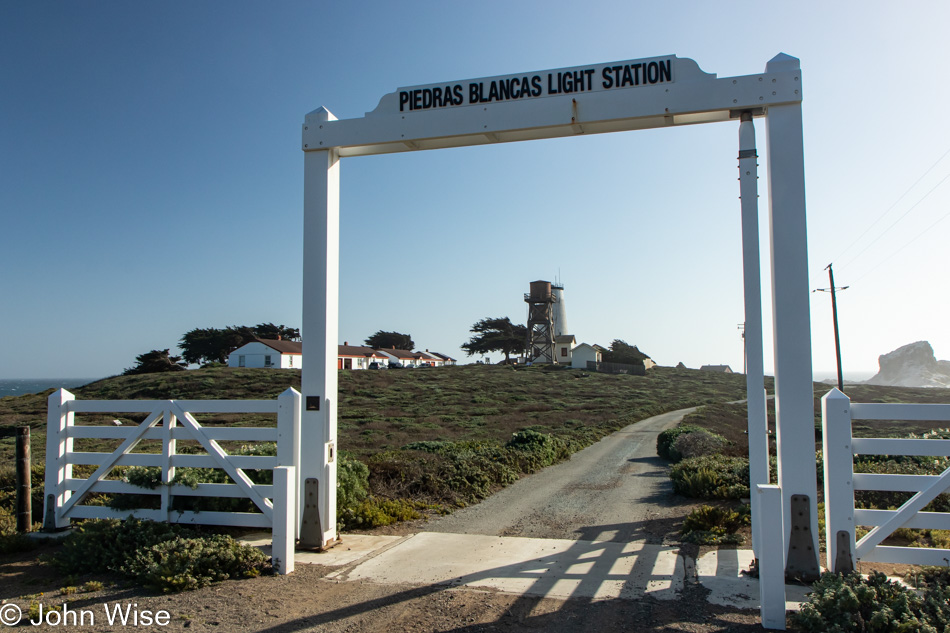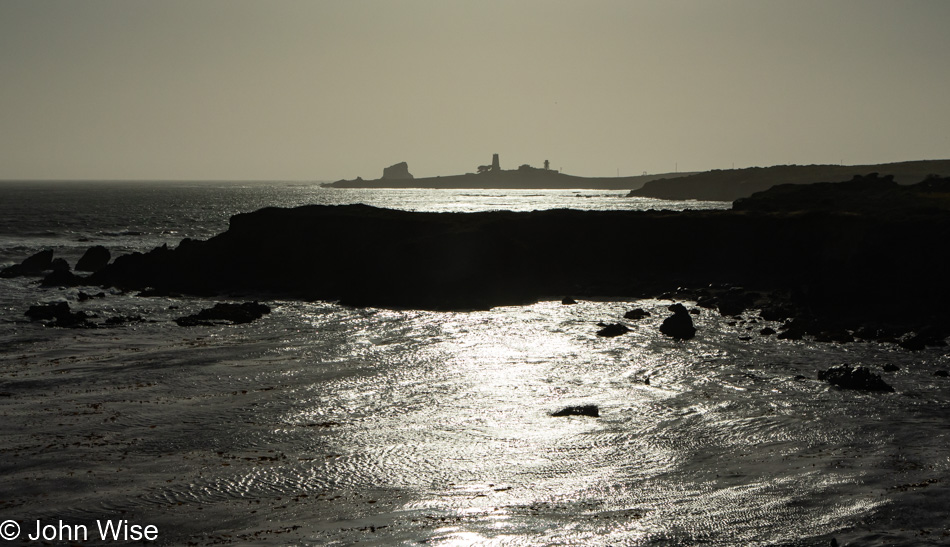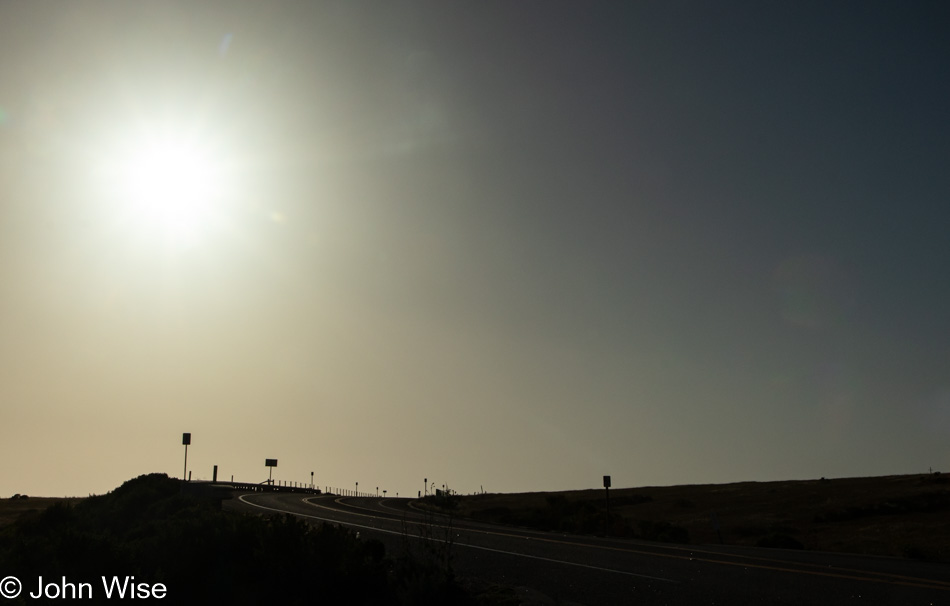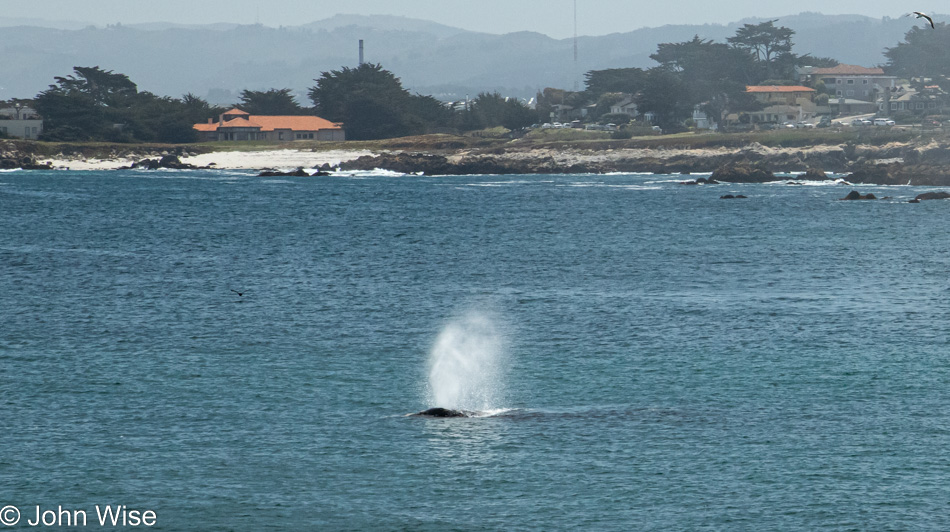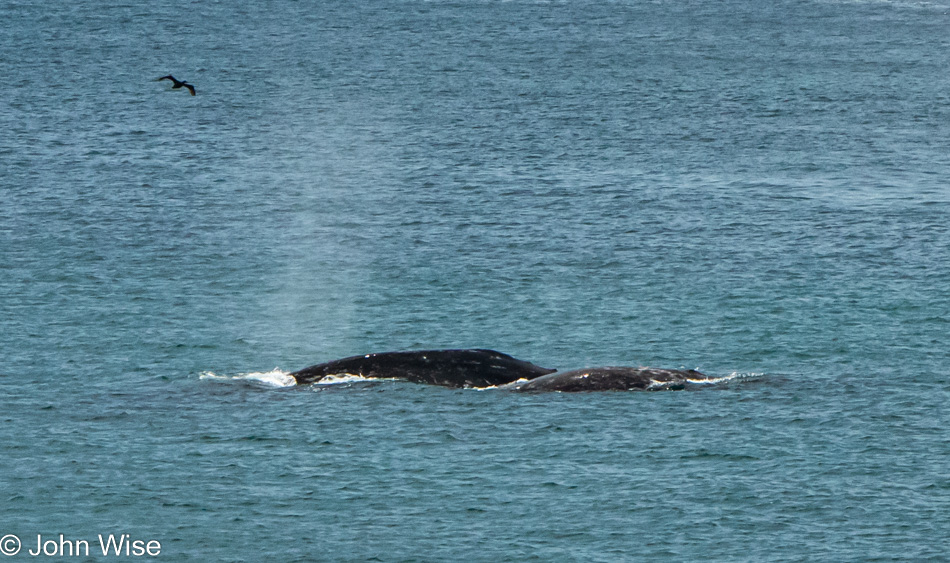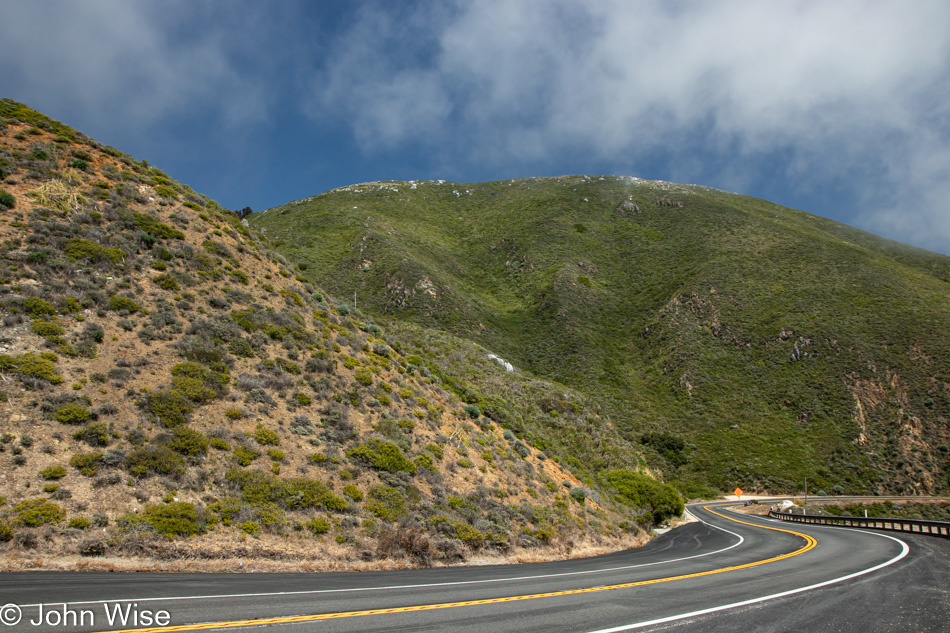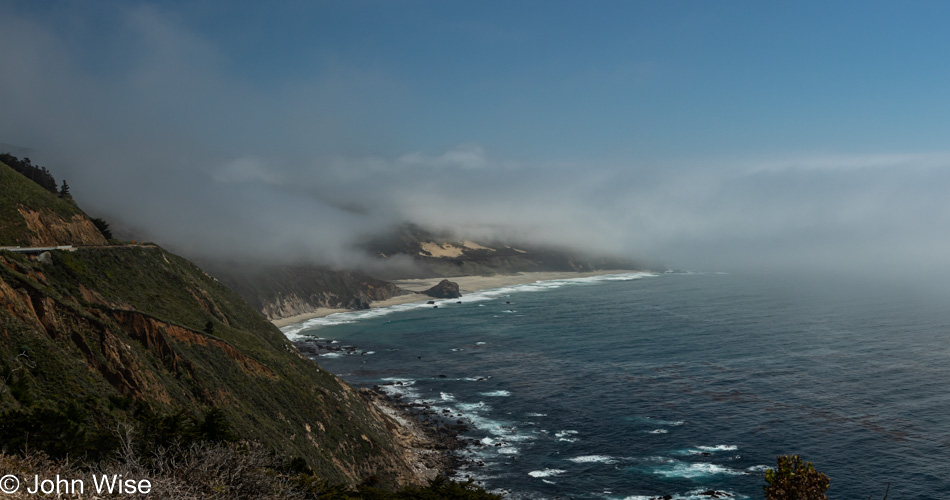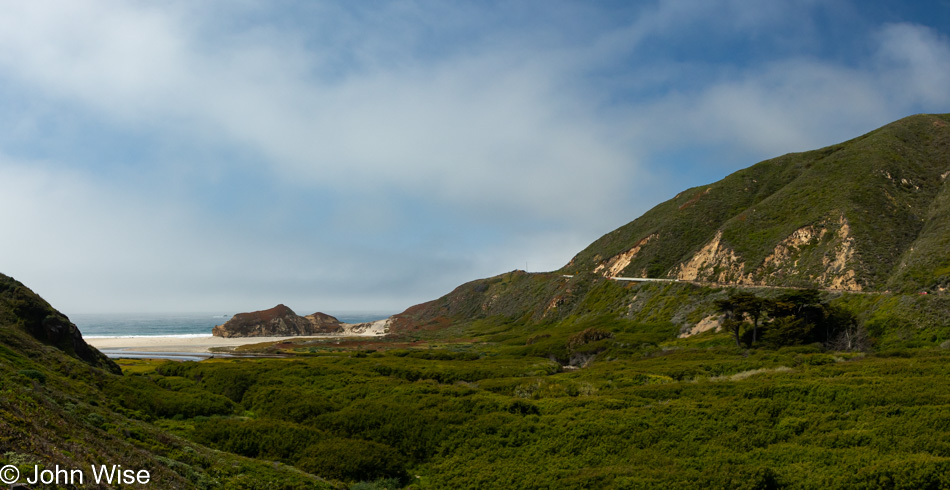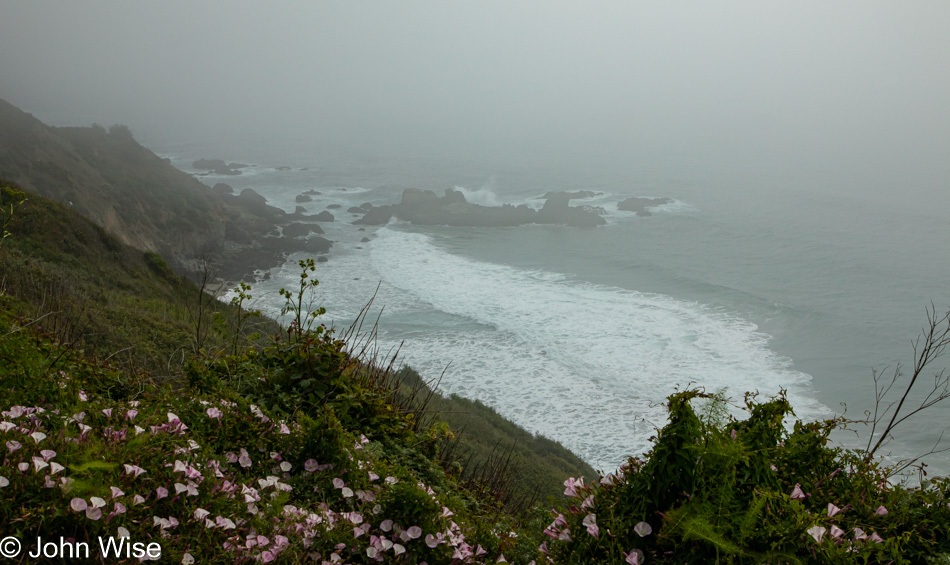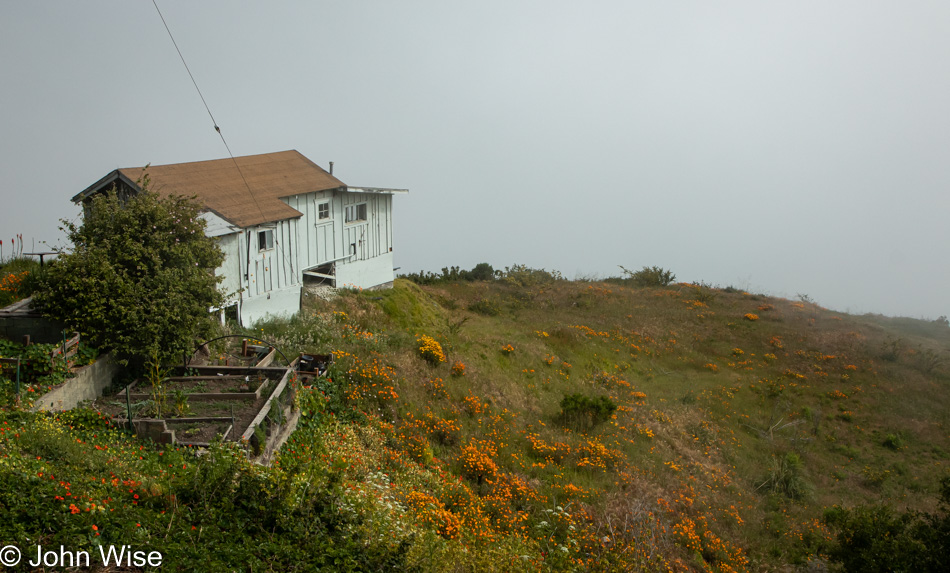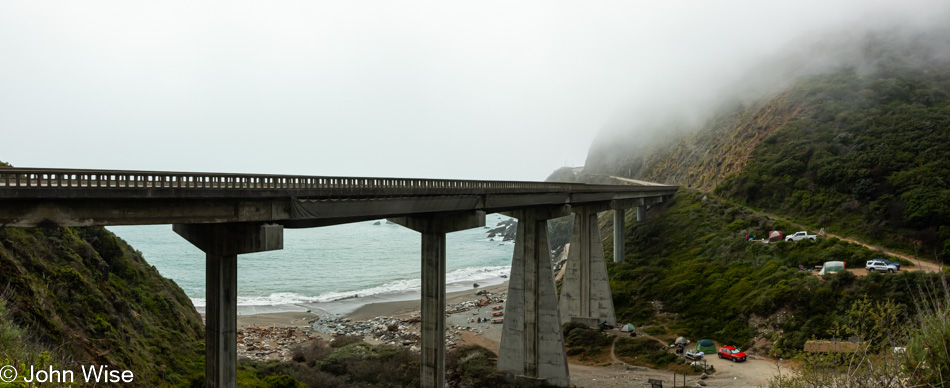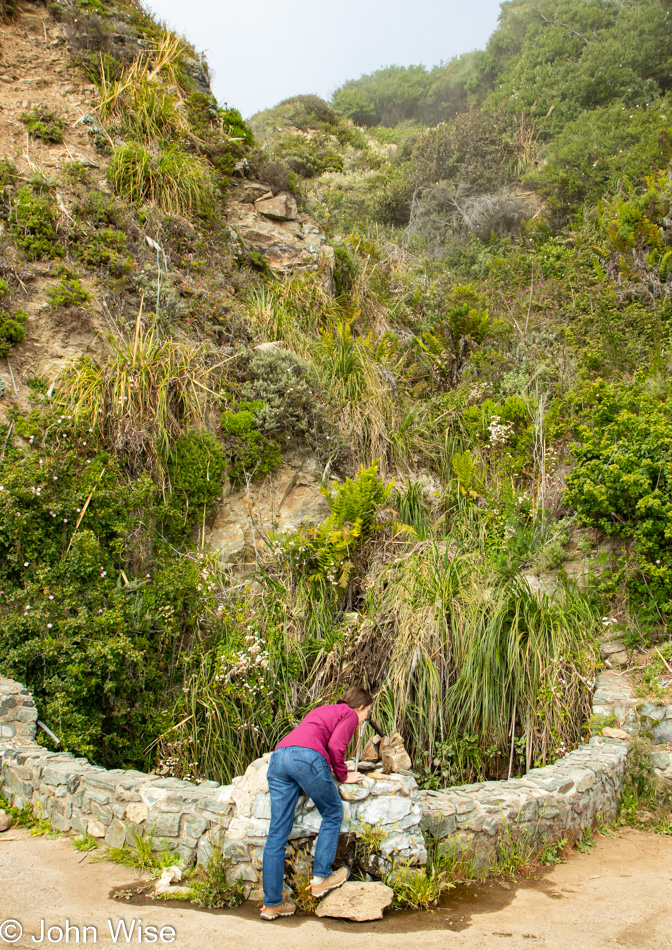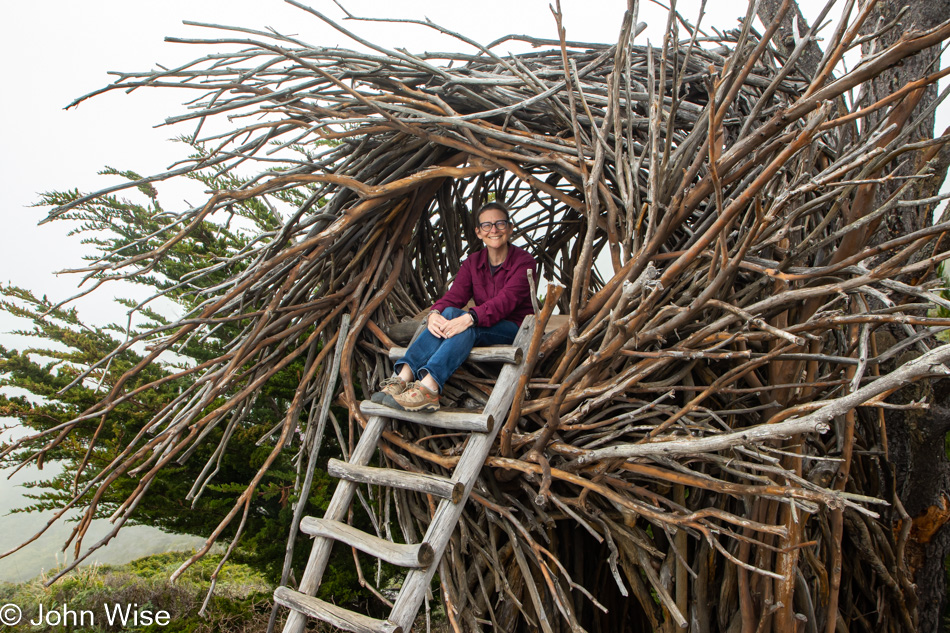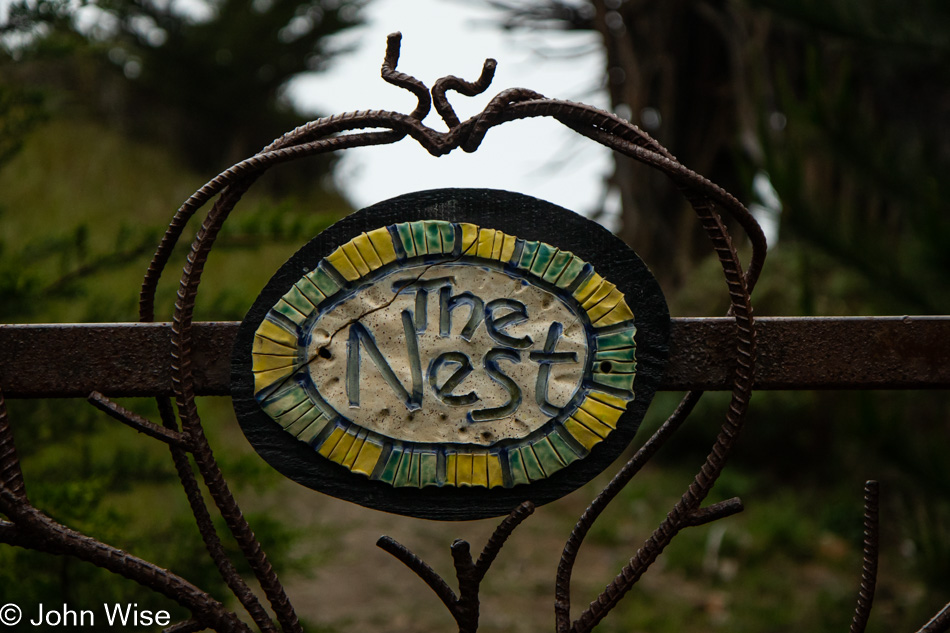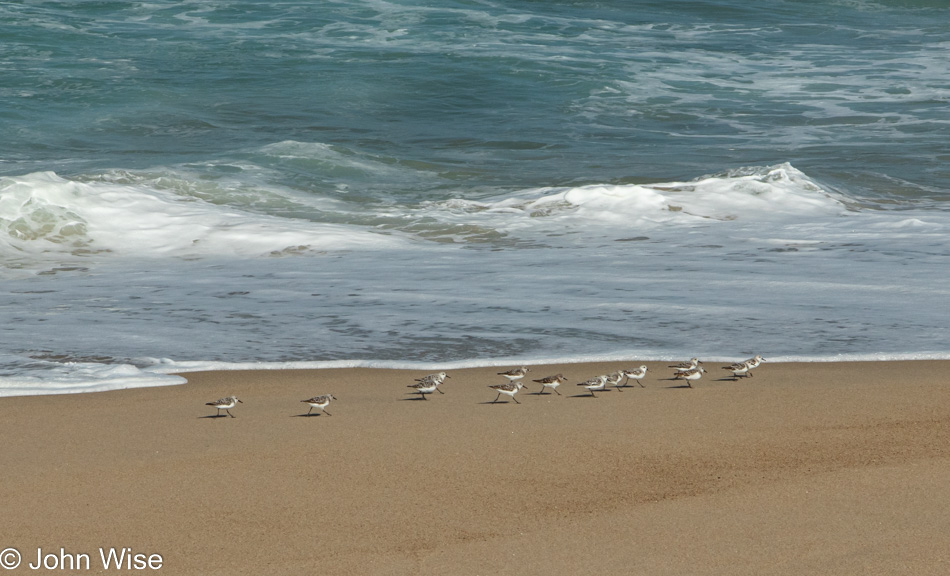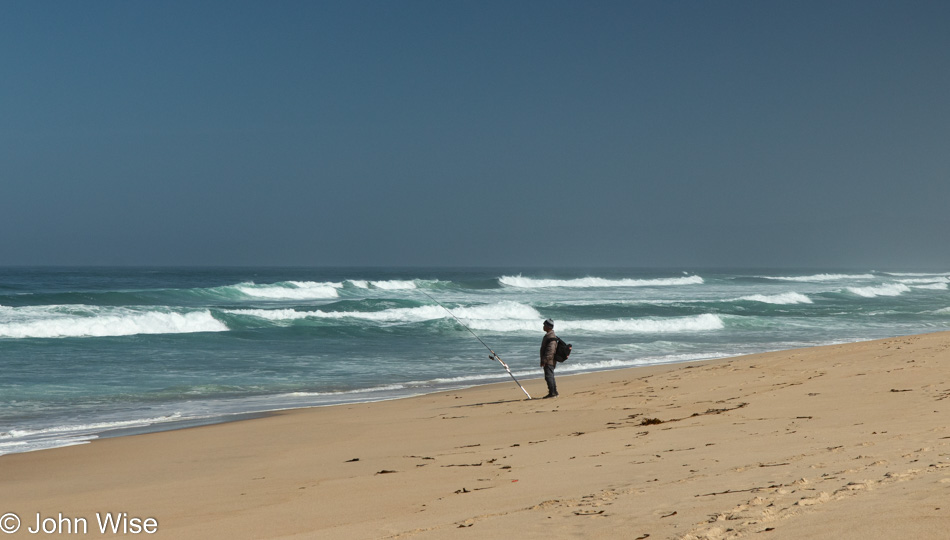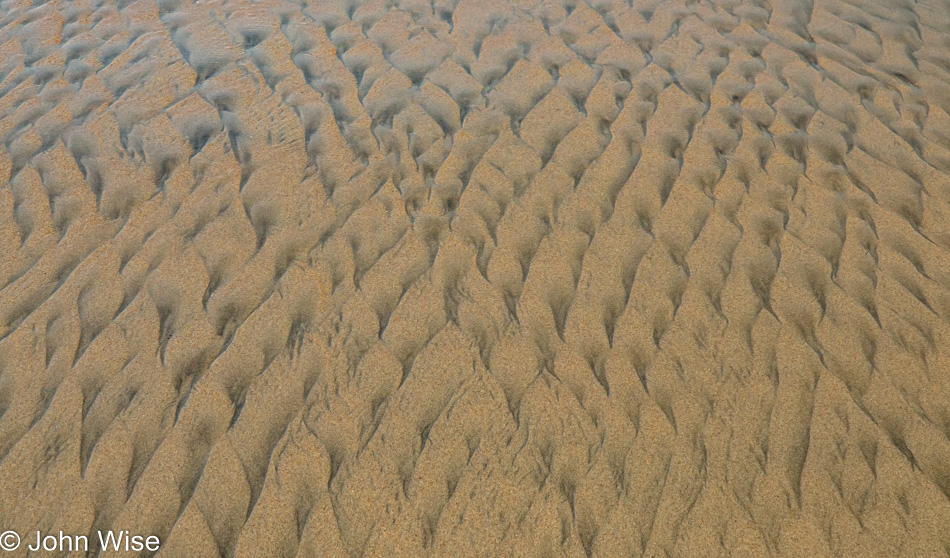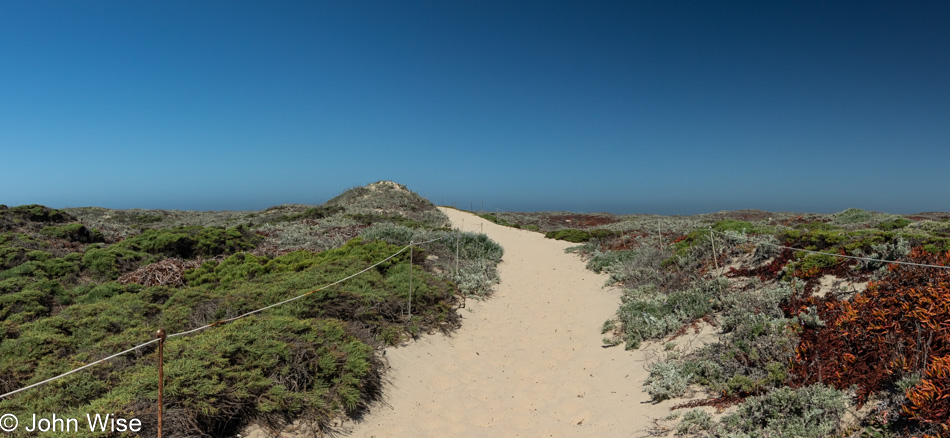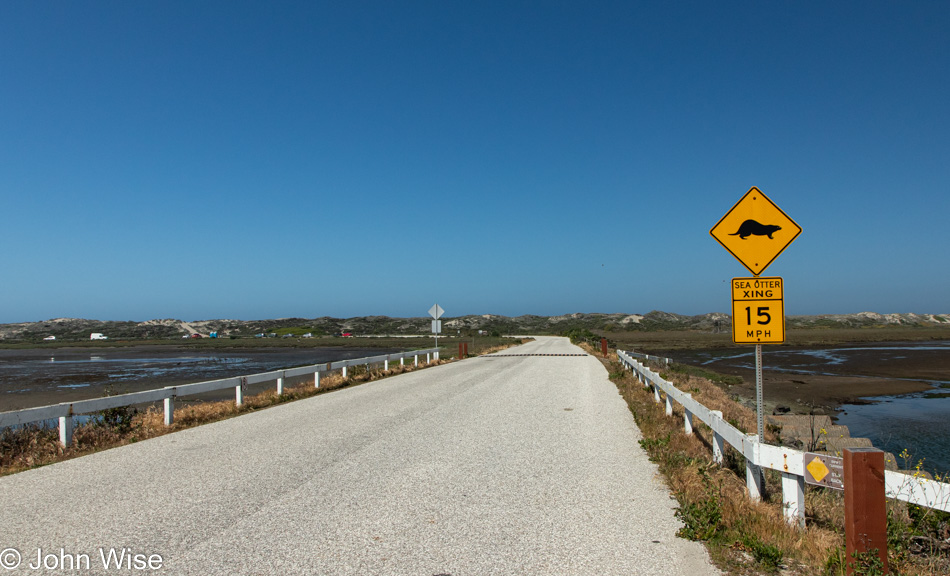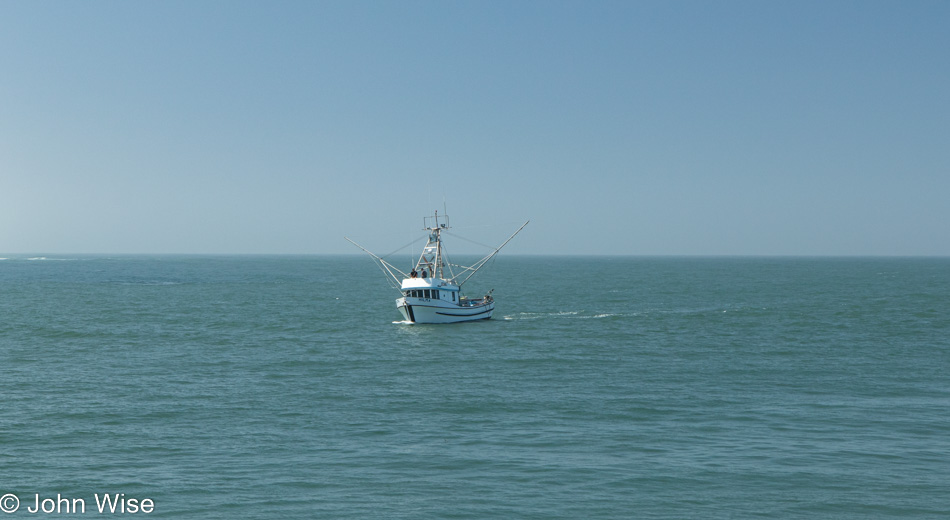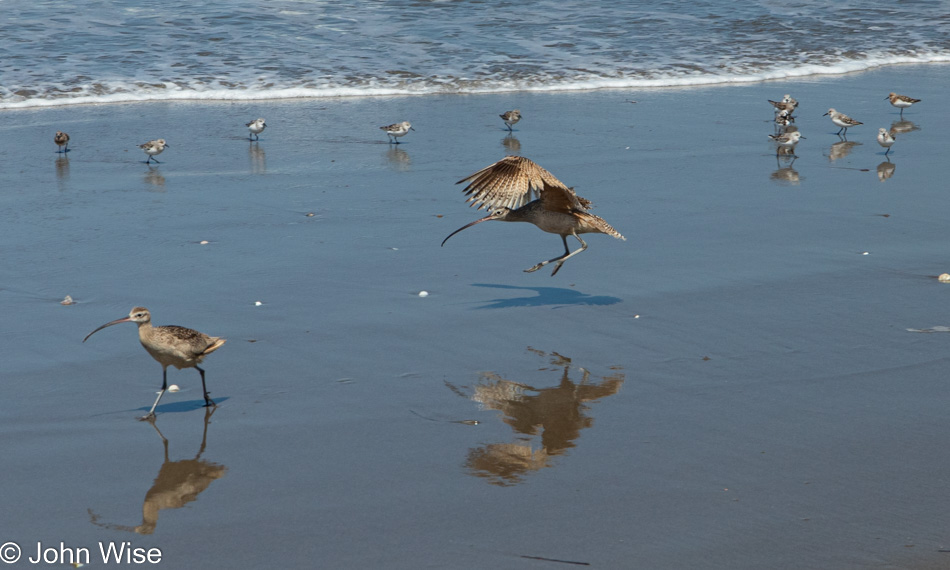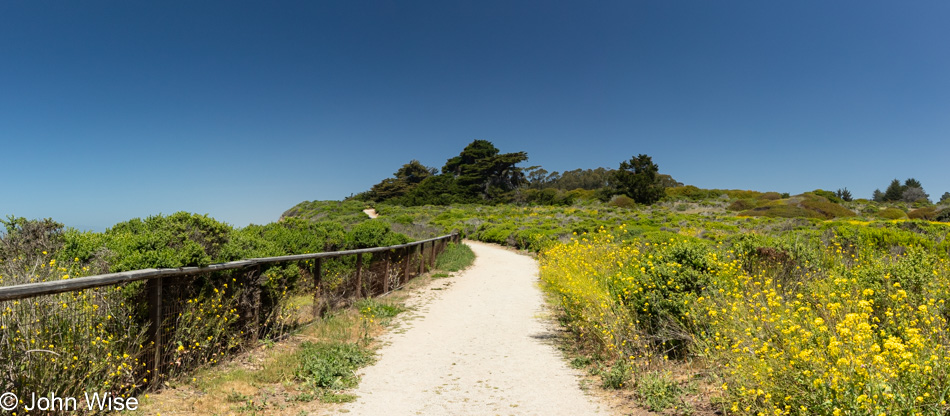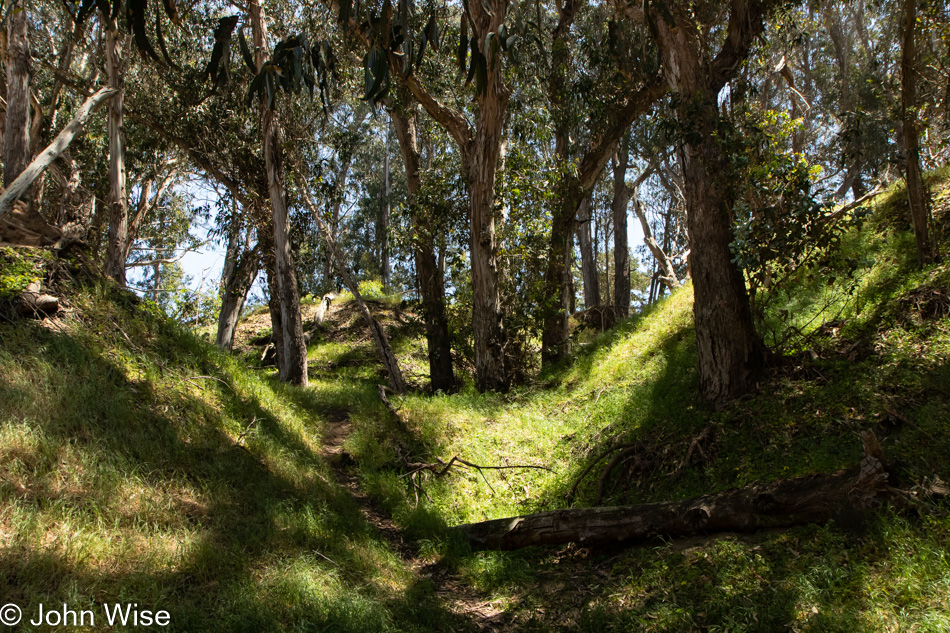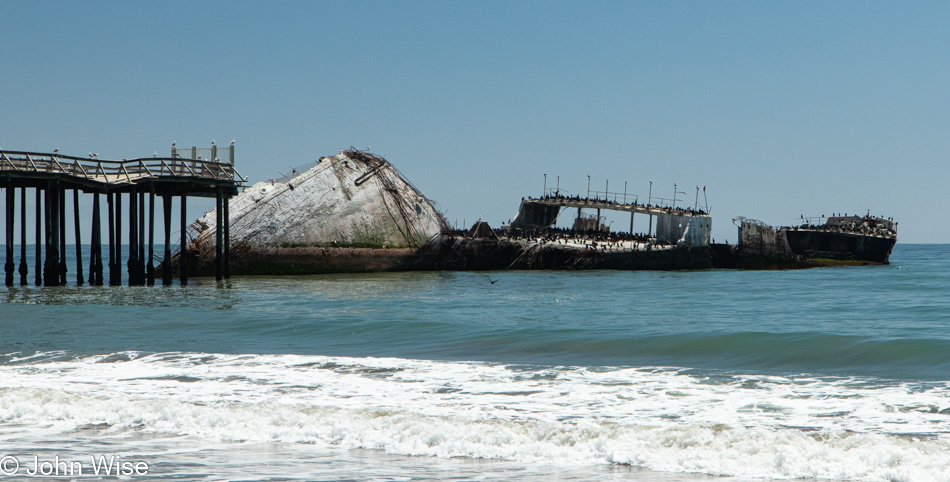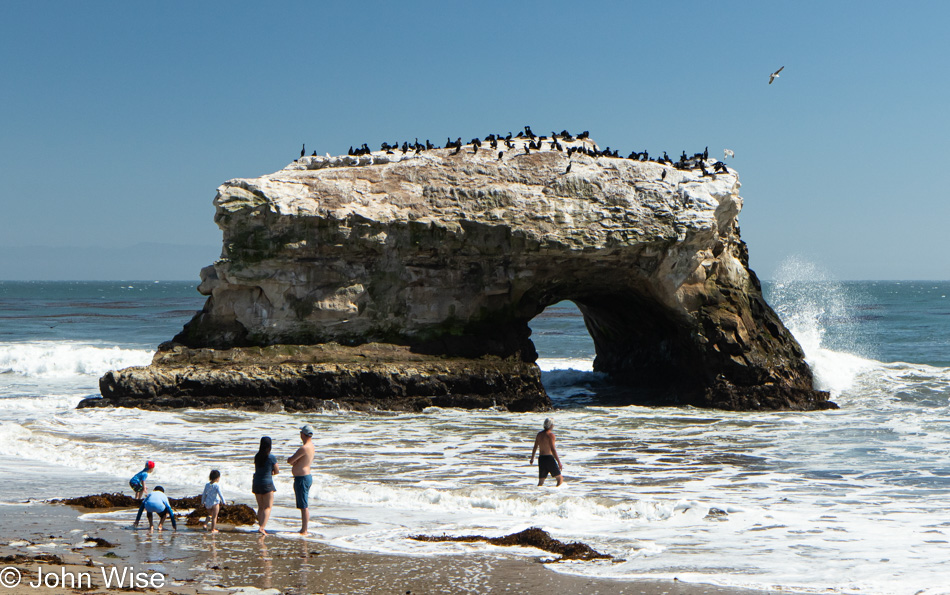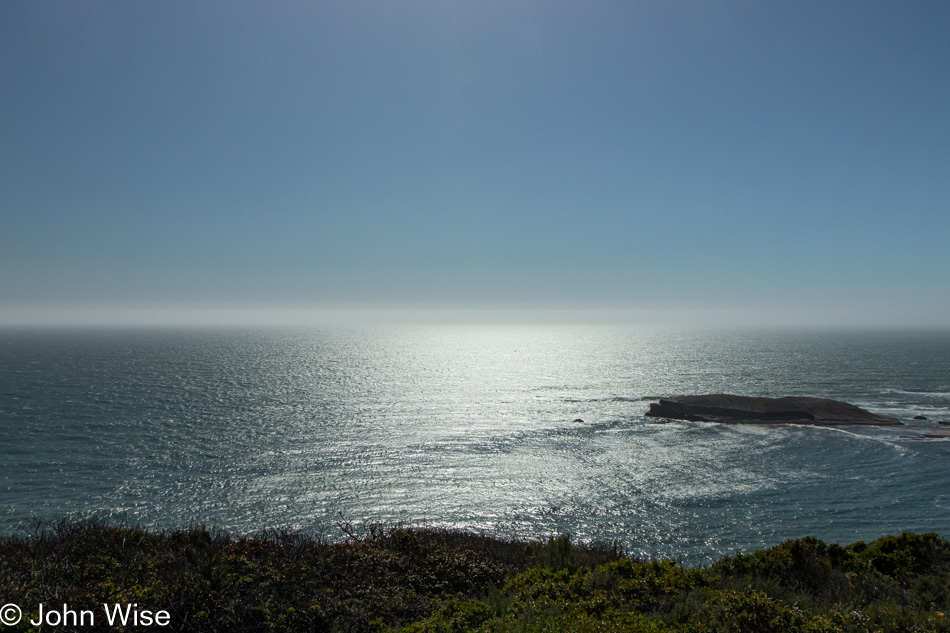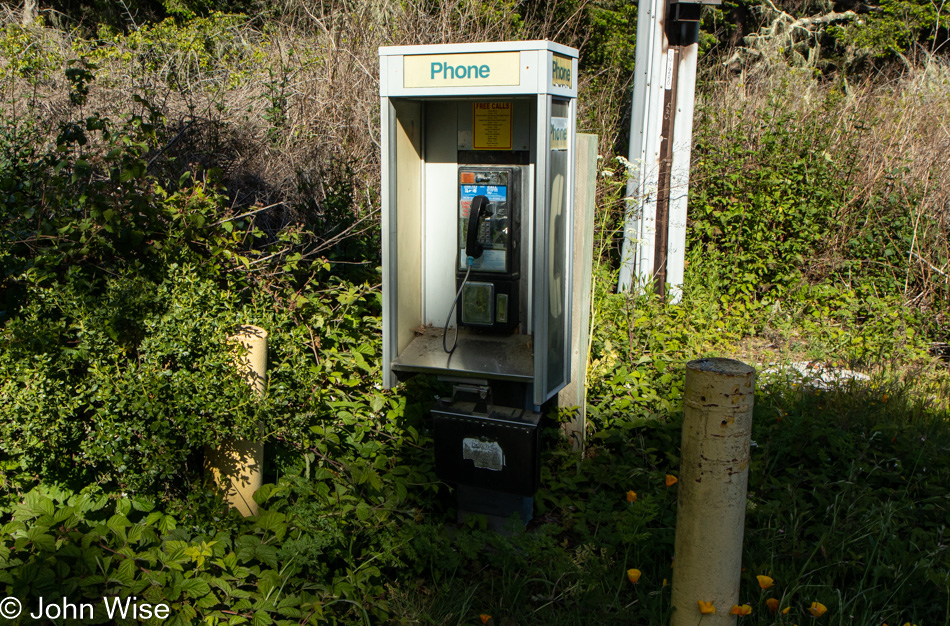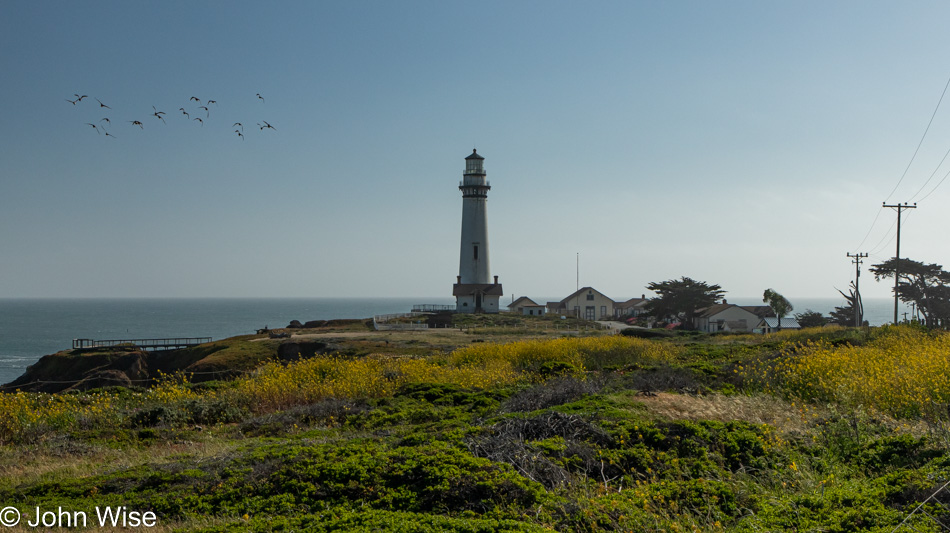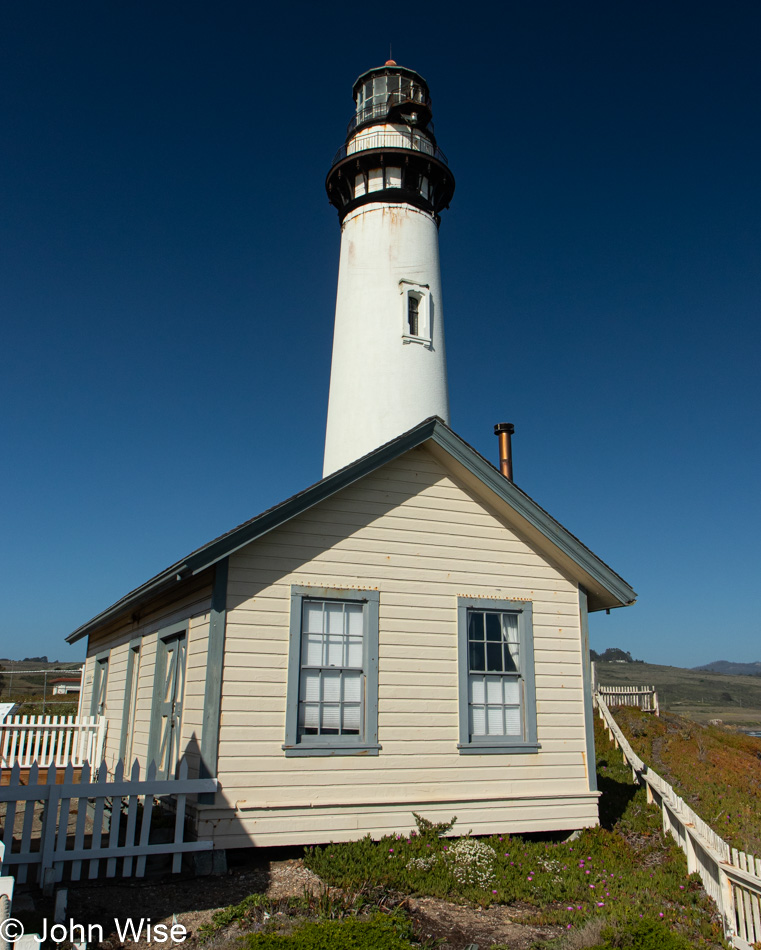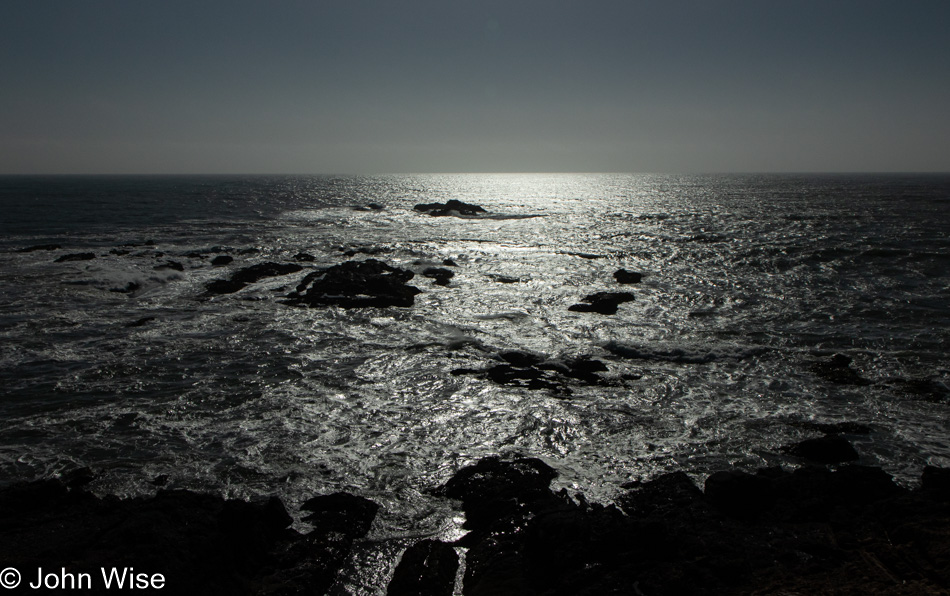
It was foggy last night as we crawled up the ladder to our Nest at the cliff’s edge. It was foggy this morning as we descended the ladder after leaving the cozy warmth of our down comforter. We left our sleeping bags at home so we could snuggle in the cold coastal air that easily flows through the perch we are calling home for a couple of nights. Somewhere in the middle of the night, I woke and looked through the branches surrounding us, and up in the dark sky, I could make out a few stars. The fog had dissipated just enough to offer me a peek at distant suns while the barks of sea lions rang out from the waters below.
Every surface exposed to the moist air was damp. Good thing I listened to Caroline about putting the otherwise unused rainfly over the top of us to help keep our blanket dry; the pillows didn’t fair as well. Cute to me was how Caroline greeted me, “Good morning, mad scientist!” I guess tossing and turning on a somewhat hard thing that at one time might have been called mattress had frizzled my hair into a scholarly disheveled appearance. Minimal, sorry, no ablutions followed, although nature’s call was heeded before we took ourselves to the comparatively warm dining room for breakfast and internet.
No, the internet is not important for these travels aside from offering Caroline a connection to do her daily Duolingo lessons and as for me, I need the connectivity to upload photos and to save blog entries. Of course, while on the road, we enjoy the luxury of having our smartphones to find dining options and detours from main roads, details that our paper maps 20 years ago were not able to offer. Other than that, we try our best to avoid the news cycle (yes, I accidentally learned while out here that Bill Gates is getting divorced), and obviously, we don’t turn on the TV unless it’s winter and we’ve checked into our lodging seriously early. One last thing about the news finding us: one year, we tuned in to NPR to listen to This American Life and a fascinating story about Curly Oxide. While listening to the broadcast out in the middle of Nowhere, Idaho, we learned that Marlon Brando died, which was back on July 2, 2004, and I only know that because I blogged about it.
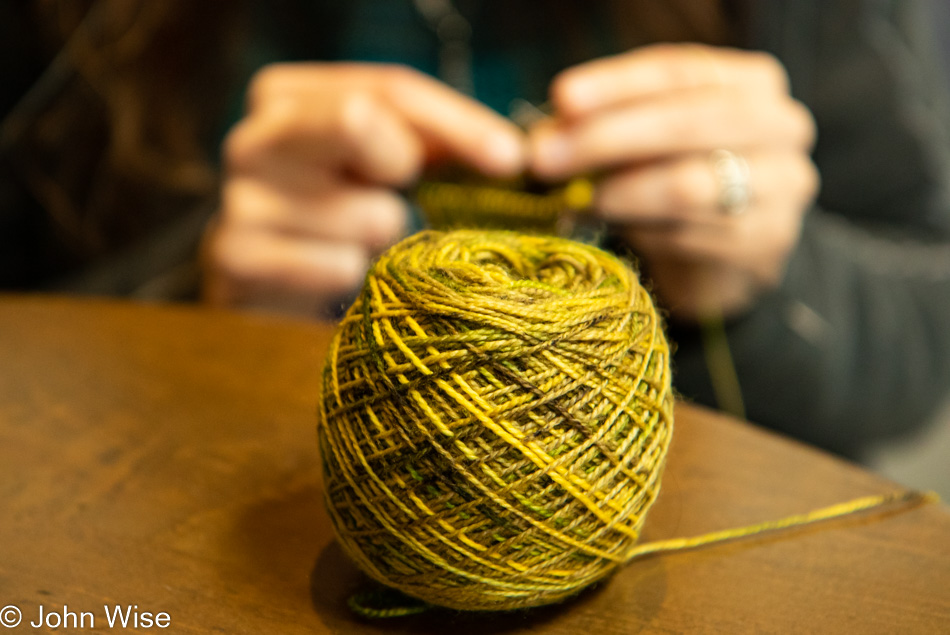
Breakfast was a self-serve affair with quiche, chia pudding, granola, and fresh fruit on offer, with the obligatory endless coffee. As we sip on that infinite supply of life force, I’m sitting across from Caroline, who’s knitting my next pair of socks, of course, and I’m writing what you are reading. Somehow, it feels like a Saturday, which I can only attribute to the last five days requiring us to be places, and now, here on Thursday, we are moving lazily without a hurry to be anywhere in particular.
It’s 9:30 a.m., and the fog lies heavily on the earth around us, so we are not so motivated to head up or down the road to our next trail or overview. Then again, there comes a point where no matter how involved we are with our hobbies, we grow fidgety, probably due to the nagging thought that we are on vacation and are supposed to be busy with other stuff. For all we know, just 10 miles south, we could run into blue skies. It’s likely going to be that possibility that will drag us away from the hot coffee supply and into new aspects of the day. But for now, I will try to delude myself that I’ll stumble on more things to write about.
By 10:15 a.m. and a bit of talking with staff about perspectives and how a pandemic is altering habits and expectations (thanks, Dan at the front desk), the fog is lifting, and we are getting our first view of the ocean from here. The sun is shining on the property, and if that’s not the trigger that kicks us out of our comfort zone into a new comfort zone, nothing will. Hopefully, I’ll be returning to writing at a new overlook soon. As a matter of fact, we spoke yesterday about having lunch at Lucia, so maybe that’s where we’re going.
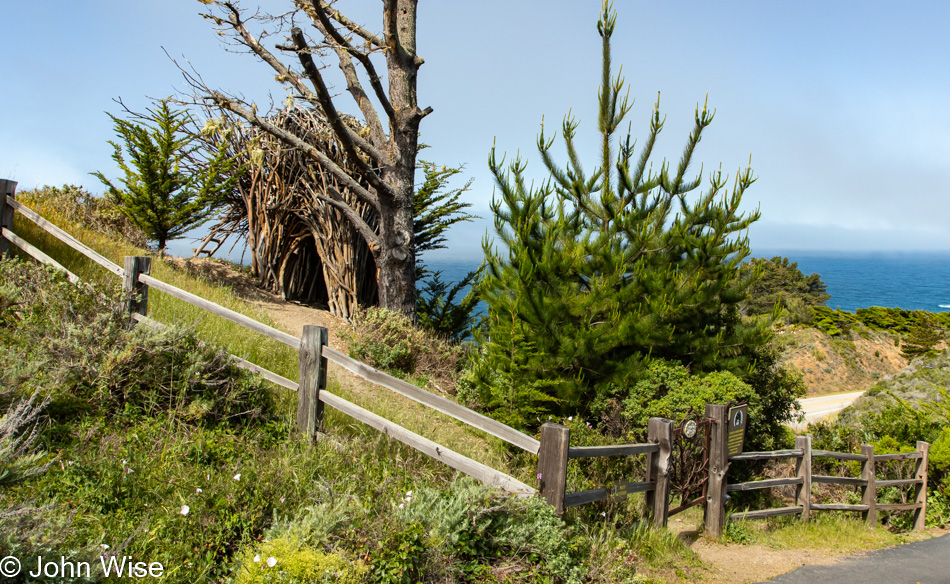
We had to head back to the Nest to pick something up, which turned out to already be in Caroline’s bag. You have no idea how often it happens that what she’s looking for is within inches of her already. All the same, it was great that she had us come out this way, not only for the view but for being at the right place at the right time.
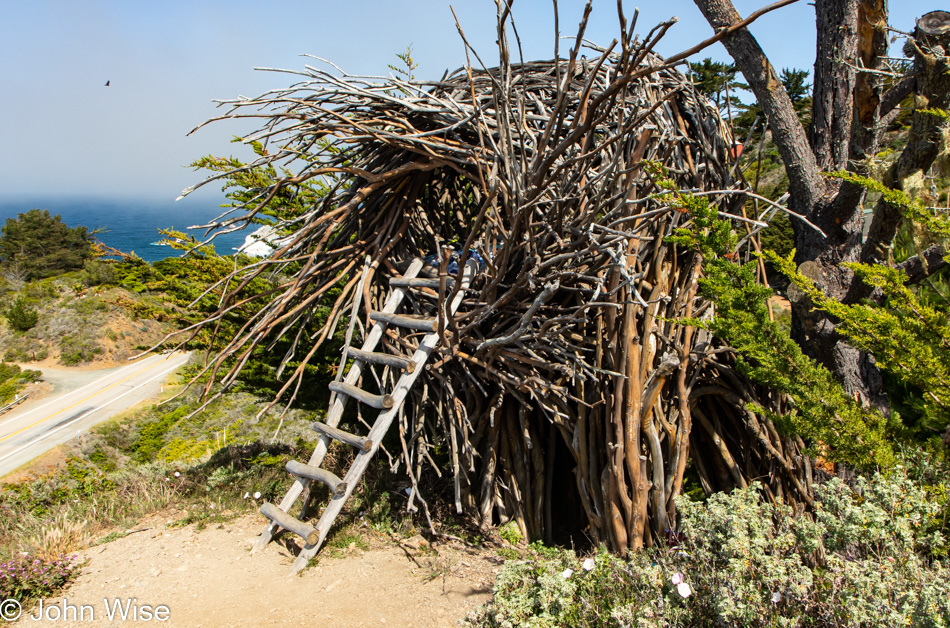
While we were up on our cliffside, a neighboring couple in one of the new sites below us offered to take our picture from their perspective; they said they’d email it to us, we hope they follow through.
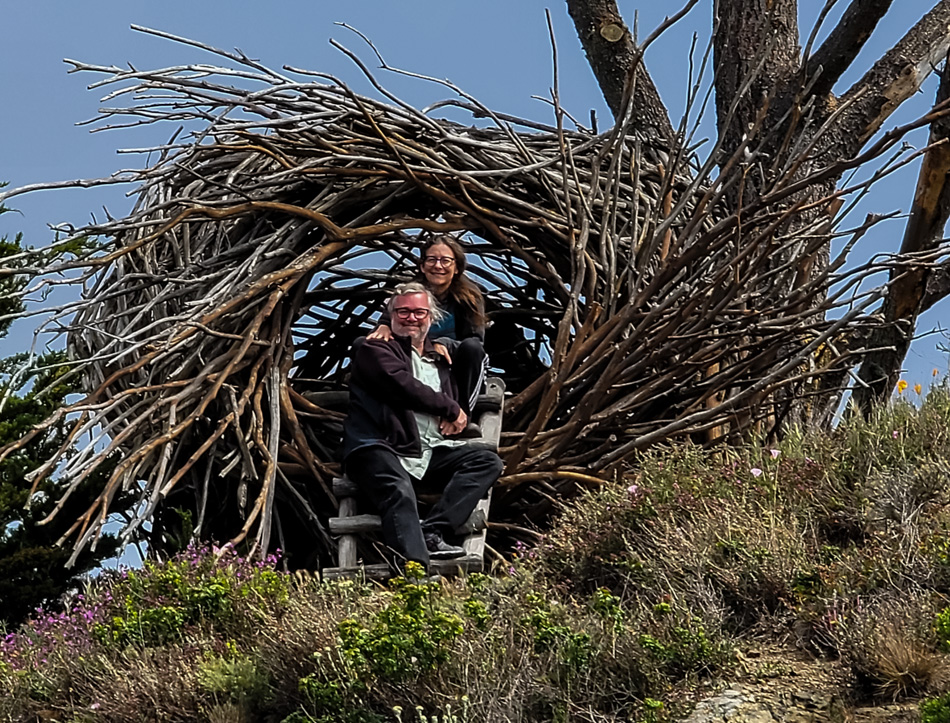
Wow, by the time we returned to Treebones later that day, the couple that took our picture from the Autonomous Tent site below had sent it to us. It’s rare that we have a photo of us not taken by me. It will be even rarer that we might stay in one of the two Autonomous Tents as not only are they booked solid for the next year, but they are priced at a lofty $645 a night with a two-night minimum. You do get your own bathroom and shower, though, and the views are outstanding.

Now ready to go, or maybe not? We turn left instead of right and visit the hillside organic garden seeing where many of the greens and edible flowers are grown for the restaurant. In a seemingly small space, every available square inch is covered with plants, and many are flowering now, so it feels like the proverbial Garden of Eden. A greenhouse, fruit trees, and a compost heap round out the garden.

Close to the garden are 3 or 4 beehives next to the Sweet Spot Honey Processing Hut. We spoke with one of the gardeners about why so many pest traps are out; they have a vole problem. A garter snake we saw hopefully catches a couple from time to time. Okay, now we’re really ready to go.
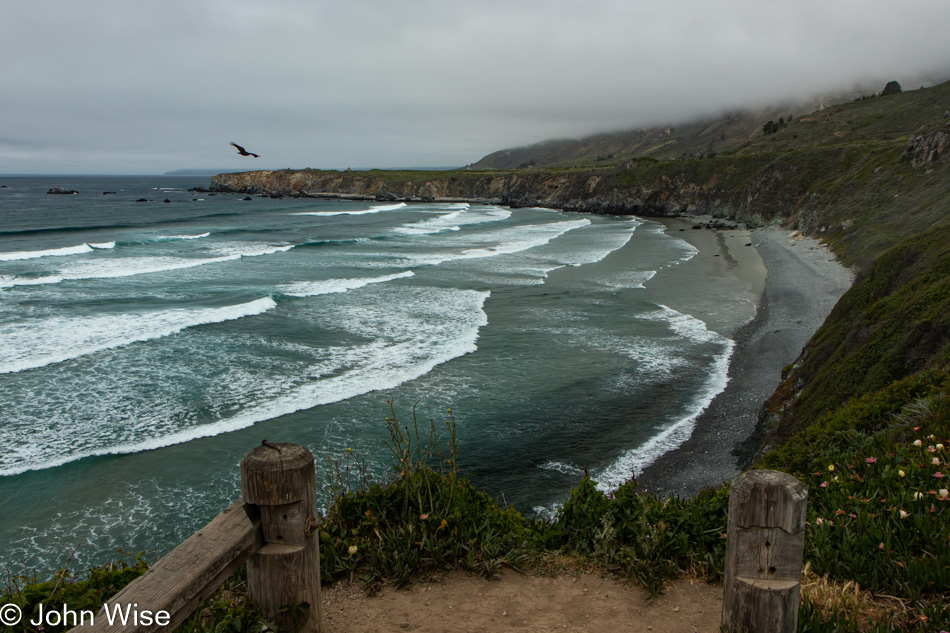
Our first stop driving north was at Sand Dollar Beach State Park, and whoever named this was probably related to the people in Phoenix who name a community Emerald Pines or Amber Creek because after walking down to the beach, there wasn’t a sand dollar to be found, not even a tiny fragment. But there was a consolation prize found in the body of a decaying sea otter, whose face a buzzard or two had been feasting on.
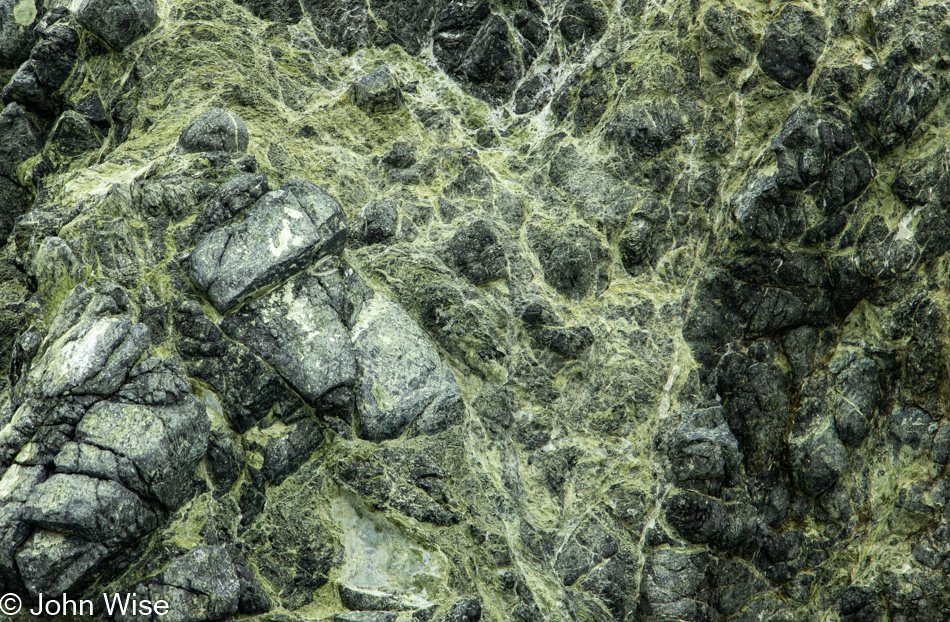
The beach itself is a quiet place. Steep cliffs surround the cove, and the beach is mostly rocky, with a couple of small stretches of sand. At high tide, I doubt there is any sand here. The rocks near the shore that are exposed at low tide, while covered in moss and seaweed, don’t have a single anemone at their base, not a seastar, nor a barnacle or mussel. In the scheme of things, maybe this isn’t the most dynamic beach we’ve ever visited, but at the speed we are moving, this is a luxury not to be in a race to see special places that draw us back or have a schedule where we stay, eat, drive, with little time to linger. As I wrote that last word, I thought maybe this trip should be titled the “Lingering On The Central Coast Tour.”
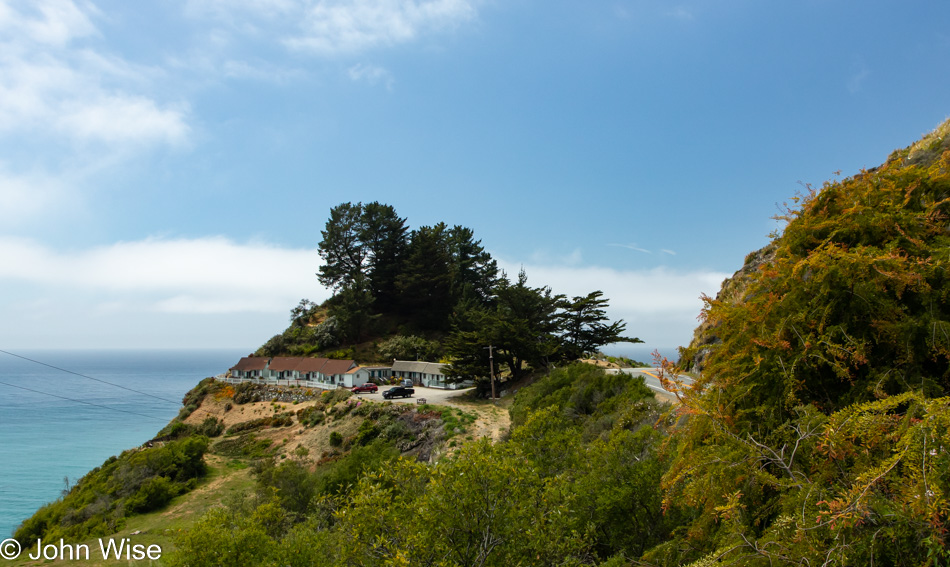
We note that Limekiln State Park is south of Lucia, which wasn’t clear in our spatial memory, but we are now hungry and heading directly to Lucia Lodge before they stop serving lunch. A huge deck below the parking area we’d never noticed before was open for diners, and there was a table open with our name on it. Greasy fish and chips for me, veggie burger and fries for Caroline will need to carry us through 8:00 p.m. as we changed our dinner reservation from 6:00 so we would have more of a reason to hang out until we’re ready to ascend the ladder to our outdoors bed.
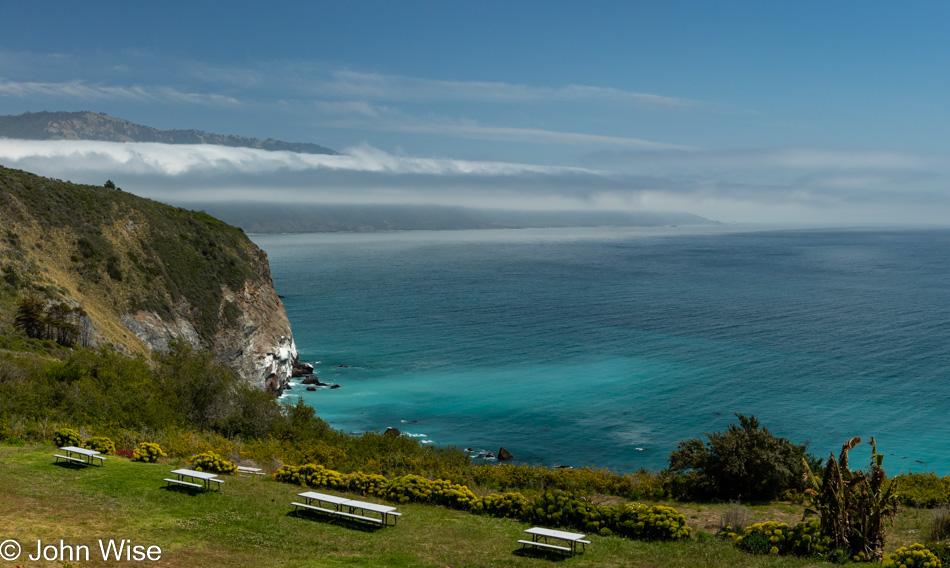
Content to just sit here on the deck at Lucia, we’ve ordered a couple of coffees and a slice of cheesecake; we are on vacation after all. The knitting needles are out, with one held in Caroline’s mouth as she adds stitches that require a fifth needle. Great, the needles are dropped, and the spoon is tightly gripped, letting me know we are about to go into battle for the larger half. Should I believe she’s getting ahead, I’ll try some whining about her attempts to dominate our dessert. She hates whining, so she’ll rage quit eating my cheesecake, and I’ll get a solid 75% of it. Right! Like Caroline wouldn’t fight for her fair share using the excuse that she’s concerned about me and my health due to “the diabetes,” so, in her mind, she’s just saving me from myself.
Patches of blue sky appear behind the fog that comes and goes before burning off to open amazing vistas that demand we just sit here. For a short time, it felt like the day was warming but then a light breeze comes in off the ocean, and maybe it’s cooling off. We’ll just have to sit here longer to get a better read on what’s what. What we can do with that information is beyond me right now so sitting here even longer might help in bringing answers. That doesn’t work, but we are given more sun. Nothing left to do but sit here and enjoy this moment of perfection.
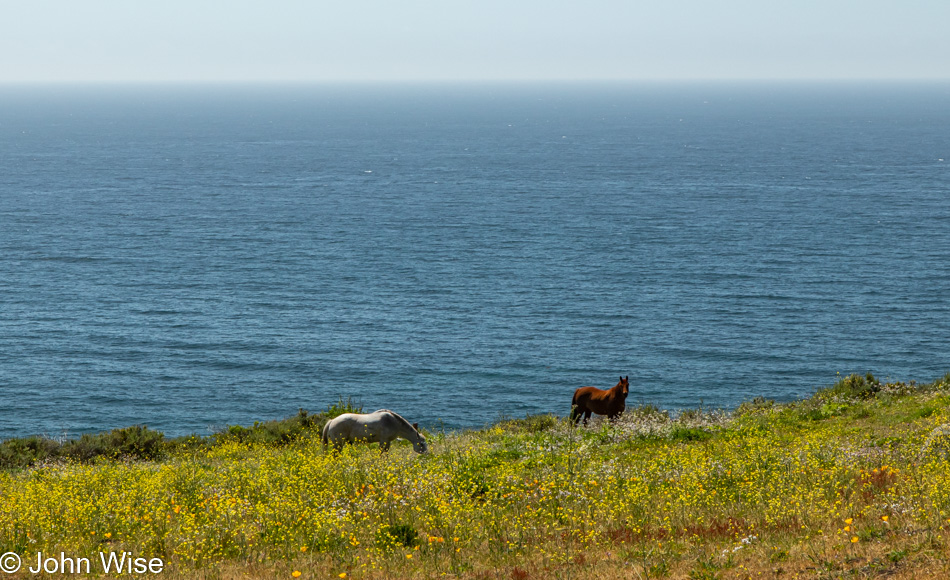
Not the best photo of two horses in a flower-covered pasture with one of the most awesome views in all of California but it’s being posted here for Katharina, our niece in Germany.
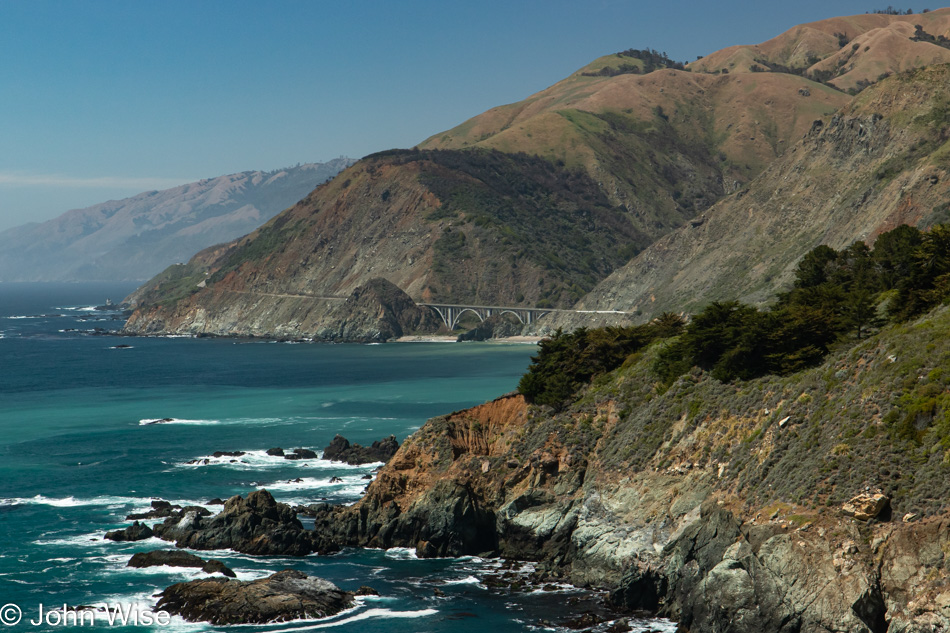
Warning, sharp curves, and familiar sites ahead, along with even more words. Maybe it was pessimism, or maybe it was the wish to have a slow day, but as I started writing this blog post, I had the sense that the fog that wrapped the coast last night and into the morning was going to be with us a good long time. And so, figuring that and knowing I’d need to post something or other to fill the page for this day, I just kept on writing before knowing that we had a lot of adventure ahead.
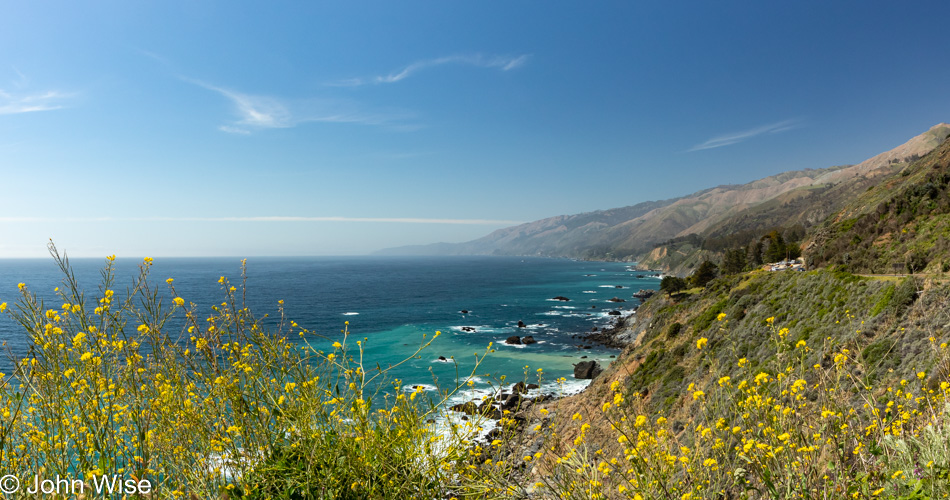
If one curve looks like another to you in any of these photos, don’t let that dissuade you from at least once in your life seeing this coast with your own eyes at least once in your life. The nuances you see in person are extraordinary, no matter the time of year you might visit. Caroline and I have been here at all times of year over the previous 25 years and never have we been disappointed, even under foul weather. How can bad weather contribute to the extraordinary? Mystery on gray, rainy days blossoms in place of the wildflowers and the clear aquamarine waters; that’s how.
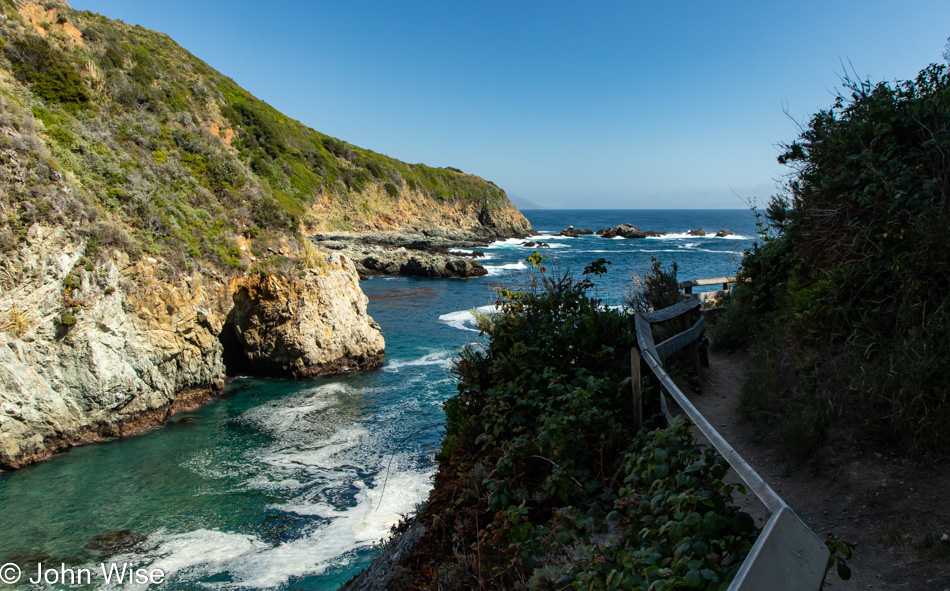
Treebones Resort offers guests a list of nearby places to visit; one of those on the list is Partington Cove Trail. There are three forks of the trail, with the first one we took going through a short tunnel carved in rock coming out into this view. In a cove like this one, you will see just how pristine the waters of the Pacific are here on the California coast. This is not a loop trail, nor is it long, though this is the only way short of owning a helicopter that you will ever see this small cove.
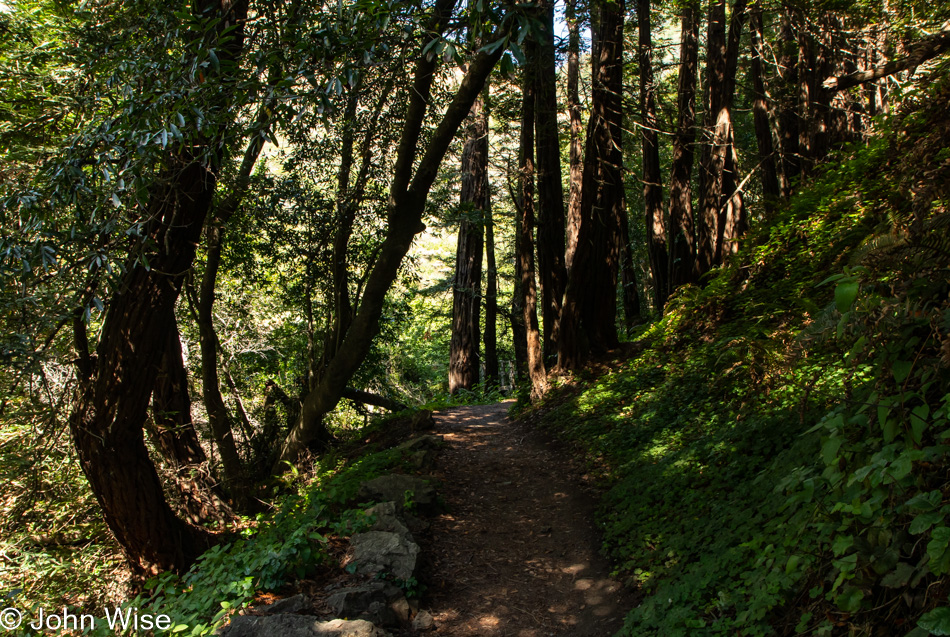
Heading back to the main trail to see the cove that this area is named after. While difficult to identify in this photo, those are redwood trees.
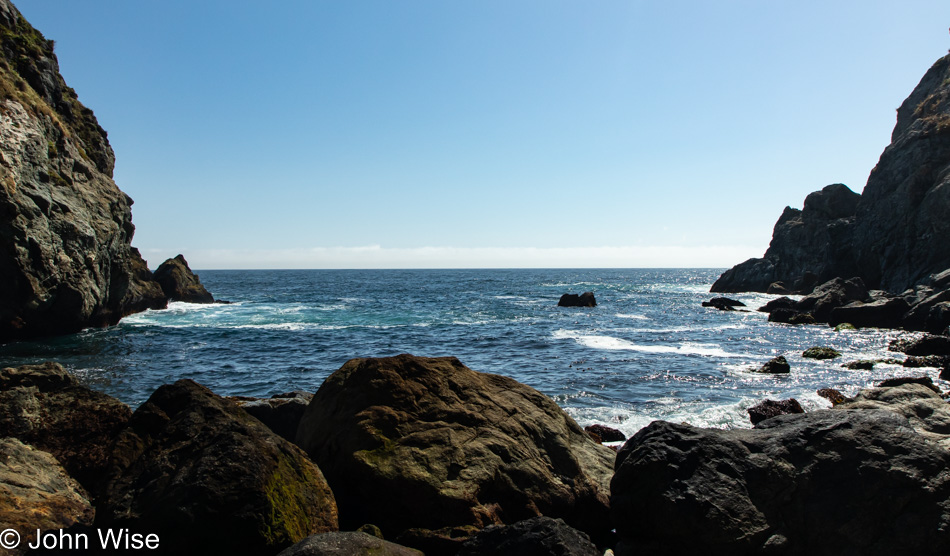
Partington Cove is a small rocky inlet with some huge boulders to scramble over should you feel like jumping in some apparently deep water where the surf will dash you to bits against the shore, but if that’s your idea of a good time, there’s nobody out here stopping you from you doing you.

On to the third fork which appears the lesser-traveled of the three. This trail doesn’t take you to the ocean; it takes you into redwoods along a small creek. I know, how isn’t that appealing to those who make this mile-long hike?
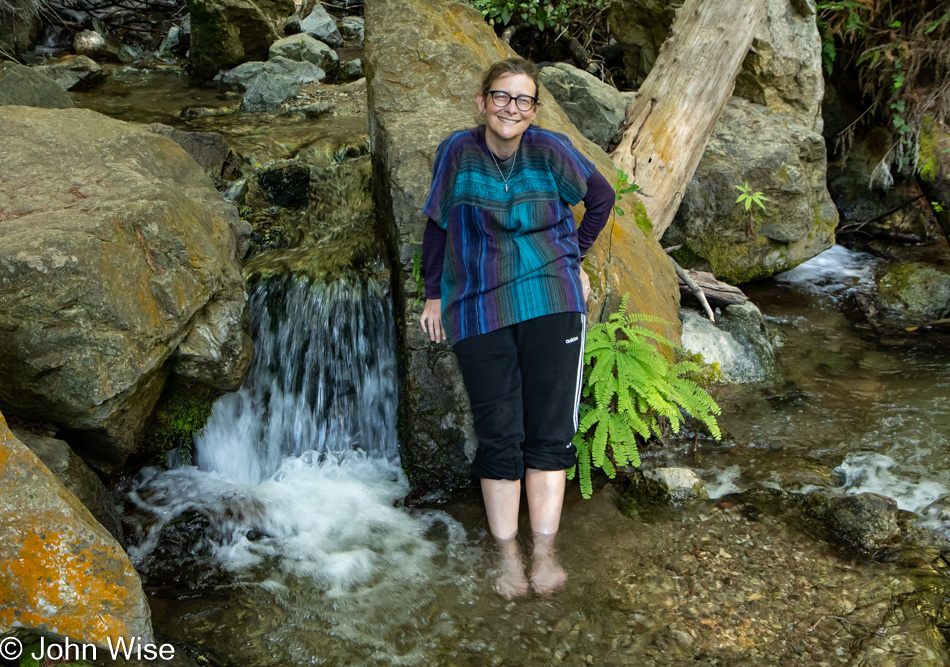
Sticking with tradition to see just how much water sticks to someone, Caroline had to step into the small creek running through the canyon. For those of you just finding this blog recently, you may not know that Caroline has doffed her shoes dozens, if not hundreds, of times to step into as many waterways across the breadth of America as she can.
Note to Claudia: While my best friend and wife has keen language skills among her many talents, dressing is not an exacting science to her. So, as you browse these entries and see her wearing these Adidas sweatpants, know that she’s also about comfort on her own terms.

Redwoods, one can never see enough of them, ever.

Flowers, too, because every time you gaze upon beauty, you extend your life another 10 minutes.

In just five minutes, I gained another 30 minutes of life. Just imagine that if you look at three beautiful things a day for 50 years, you’ll add a full year to the time you have to explore life!
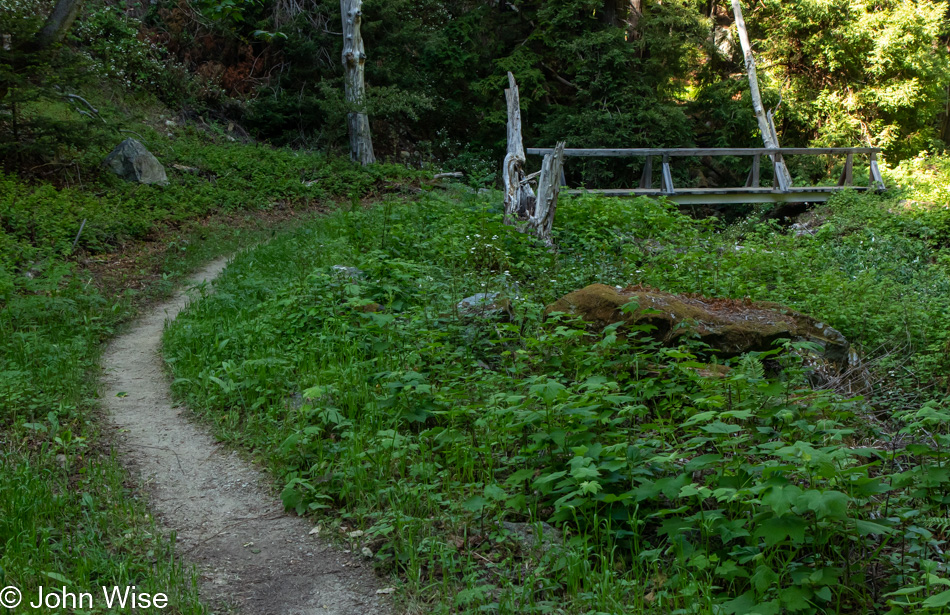
Blam, another 10 minutes added to my reserve of time. By the way, we are no longer on the Partington Cove Trail but are now across the highway, where we spotted another path; this one is called the Tan Bark Trail. Strangely, it wasn’t on our list of recommended destinations.
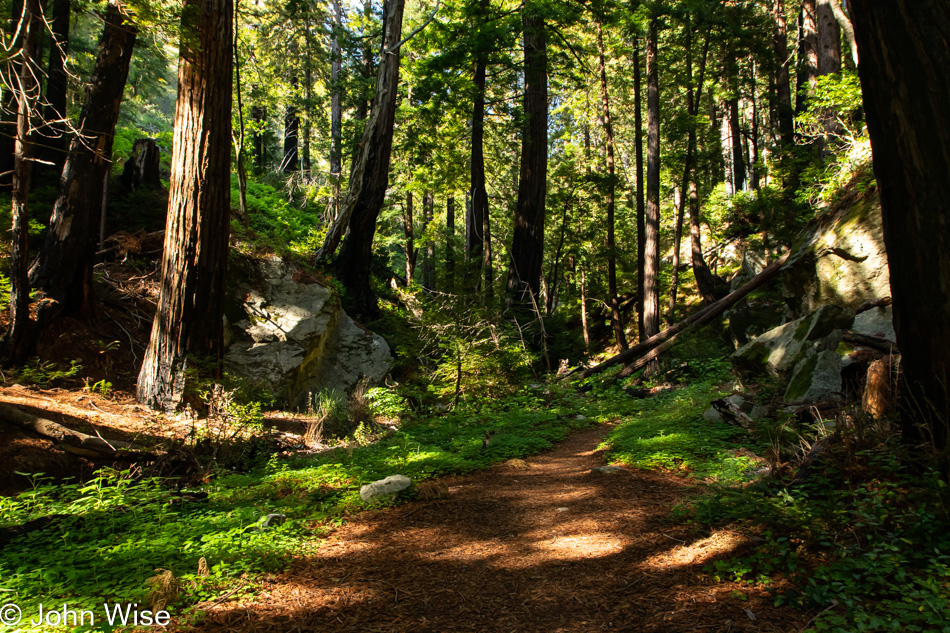
Caroline and I often joke, probably to the point of annoyance if you had to hear it for yourself, about certain places being the Swiss cheese of sights. Meaning, just the common everyday old stuff of no particular interest as a road stops being a Scenic Highway while we feel like we are still on that special designation. Here we are, on this hike into a forest that we find spectacular, and yet, it didn’t make the list?
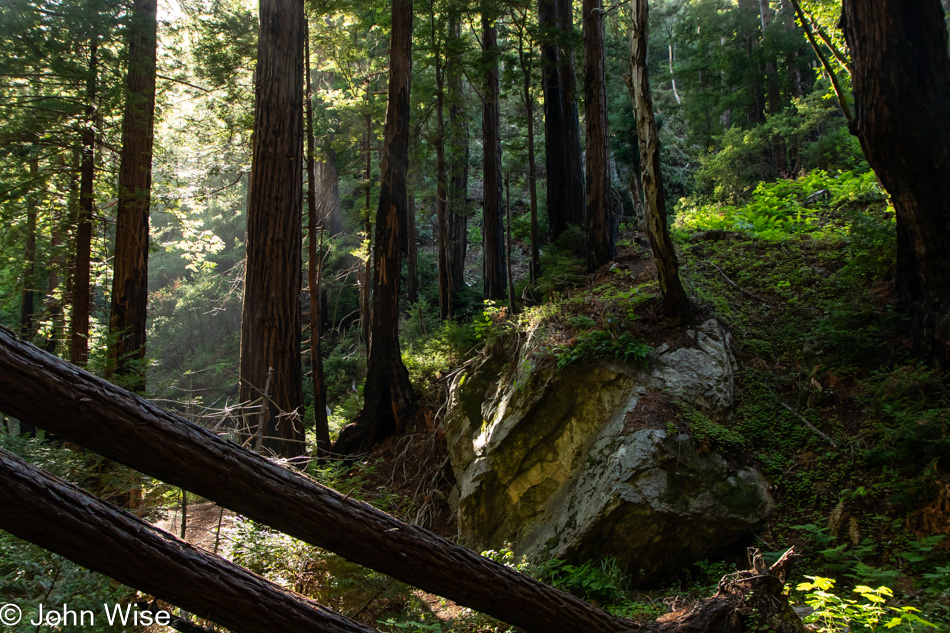
Consider that you are only seeing a pale representation of nature on display. All the smells, sounds, and ethereal depth painted by contrasting colors and dancing lights are lost in these photos. I suppose this is as good a spot as any to share with you that Caroline has added a new word to the lexicon; it is photogenous. We were approaching something or other out on the road when she attempted to describe a view as being photogenous, so we are going with it, and you’ll be reading more about how photogenous places can be.

My apologies should be offered as I didn’t warn readers early on that this post features 45 photos, 46 tons of beauty, 47 trillion words, and this one purple lily.
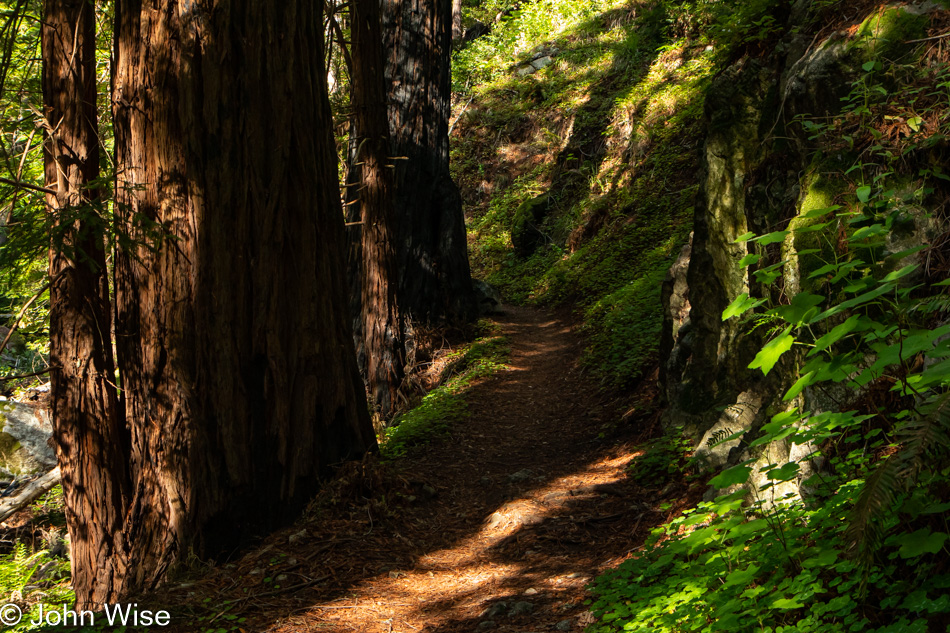
We’re still on the Tan Bark Trail as we are enchanted in this narrow canyon and astonished that no one else is here.

This photo is especially for Caroline as she has a thing for long exposures of running water, and I know she’ll be surprised that I managed to get one without a tripod or nearby tree to steady the camera.
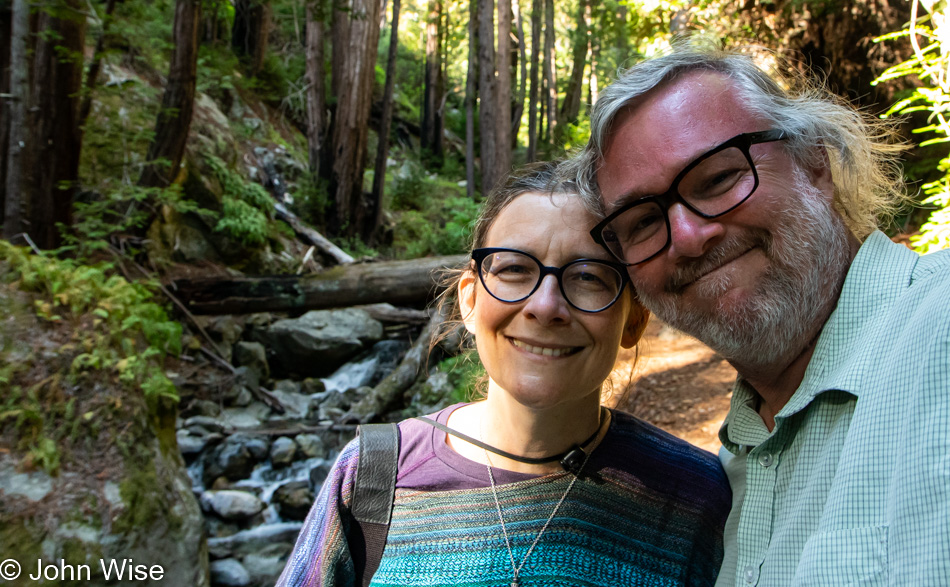
She asked that we take a selfie here as it’s been days since we last took a photo together. Well, maybe you can see from my color why I might have been reluctant to capture a reminder of the wicked sunburn I adopted. You can see in Caroline’s skin tone what sunblock and a hat do, compared to Mr. Macho-I-Don’t-Do-That and a deep red coloring that I prefer to call blushing.

Attention Readers: You are now leaving the trail for the next part of the adventure of John and Caroline.
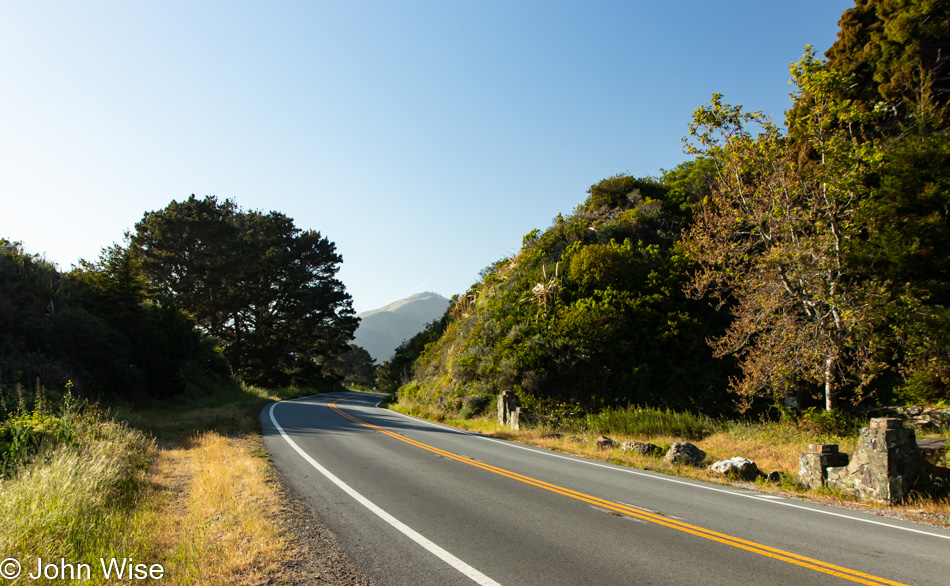
There are a number of natural springs along the Big Sur Coast. Almost 100 years ago, they were tapped as drinking fountains for travelers on this old road; today, only a few still function. This is the Rigdon Drinking Fountain that no longer offers passers-by the opportunity to quench their thirst.
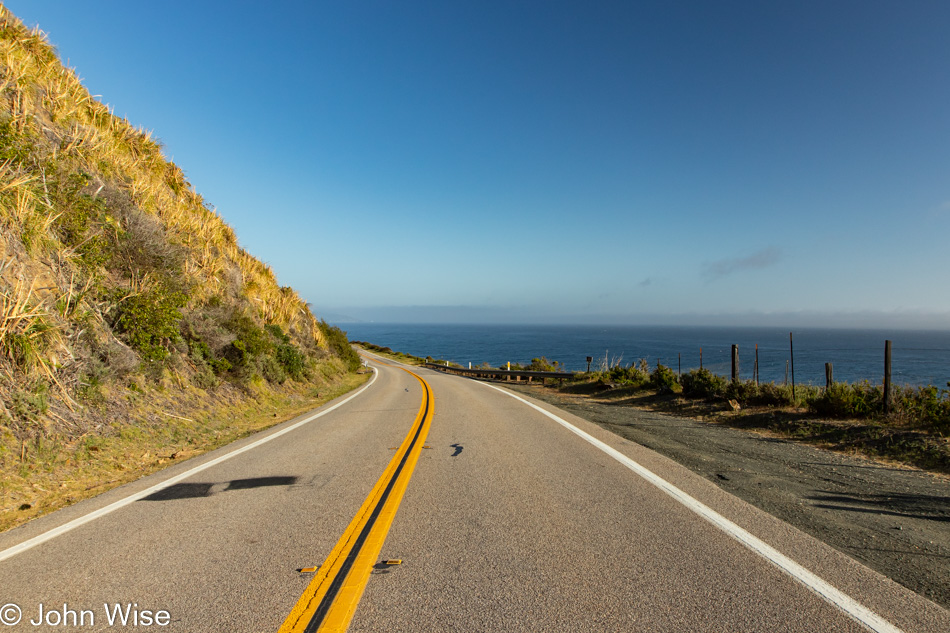
Should you be wondering how close I am to finishing this post, I still have a baker’s dozen of photos remaining. Does this image have a story, John? Not really, other than we find it to be an appealing view, and it will likely be yet another powerful reminder of our good fortune to have been out here once more.
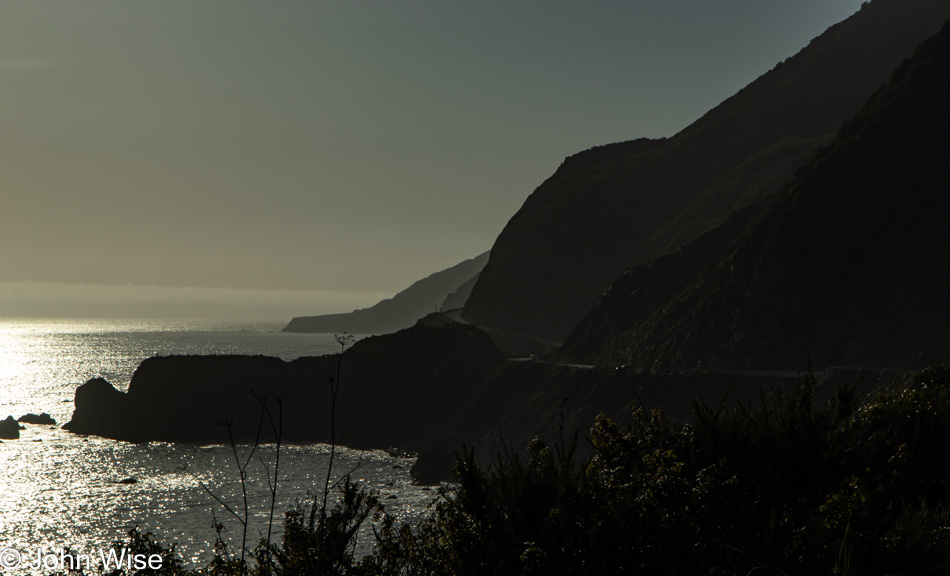
The appearance of the coast changes dramatically as the light shifts over the course of the day. Many of our travels on this highway have been expedient due to a lack of available time to linger, but these eight days directly on the coast were meant to offer us all the opportunities we might be able to take advantage of. So, here we are, looking back and then forward again.
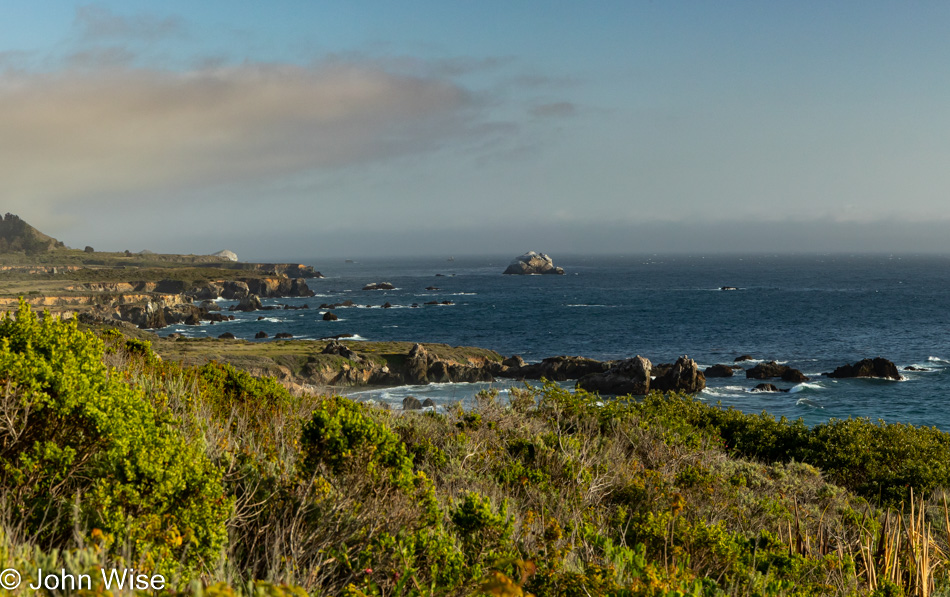
Forward through Pacific Valley without a great vantage point to grab a photo. There’s a lot out here that cannot be seen from where I pulled over but there was nowhere else to do that, and so this is the best I can offer for now.
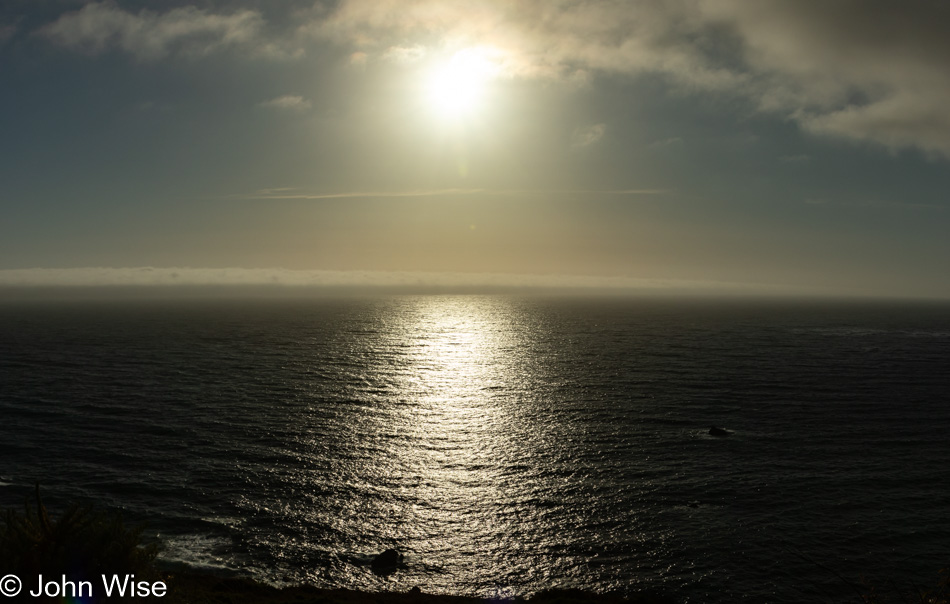
This is one of two “conundrum” shots. I should have made do with one image of the late-day sun shining in a narrow band of warm light on the calm ocean, but I loved this shot as much as I loved the sunset view four photos below.
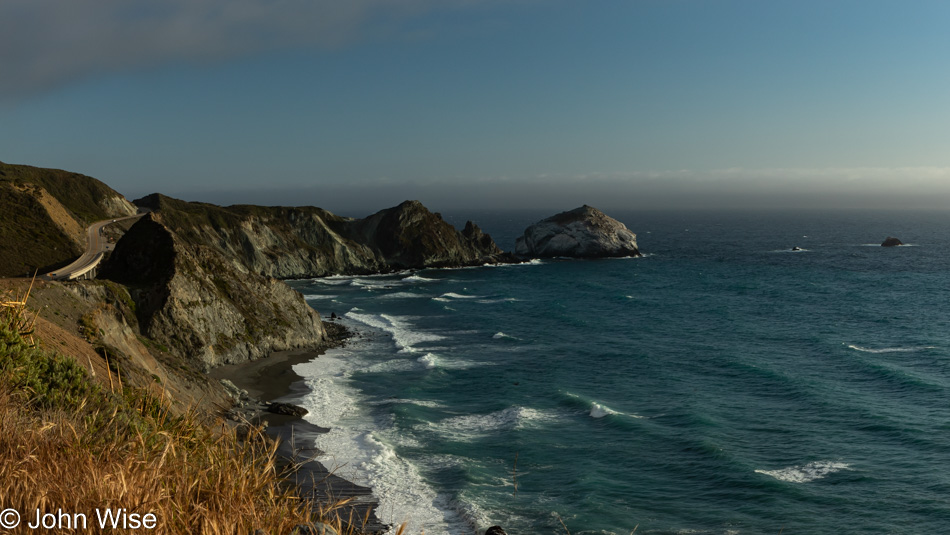
There’s a beach down there, not the one in view, but just beyond the jutting rock on the left.
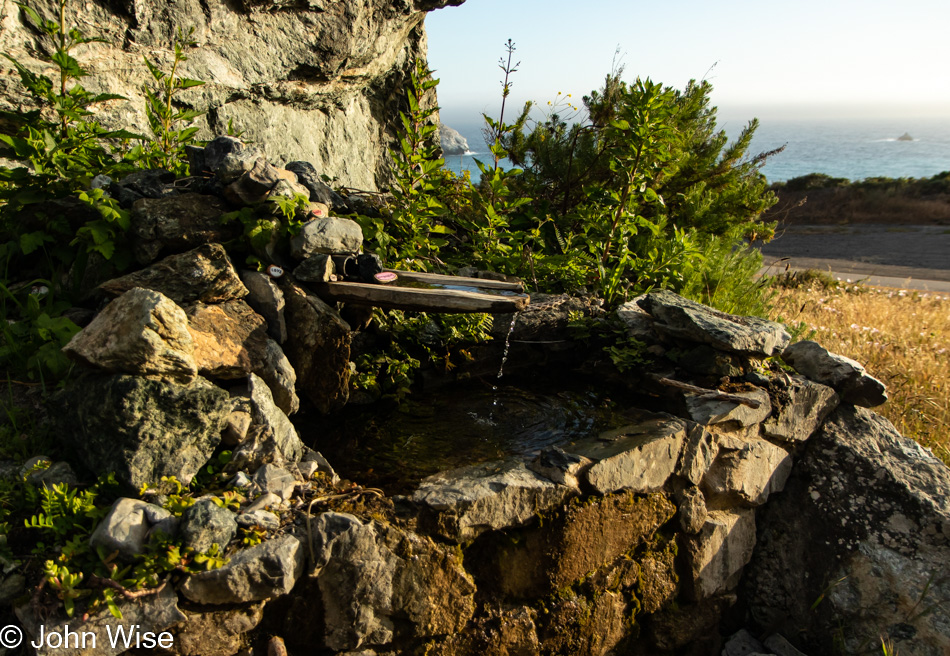
But before we visit that beach, we have to stop at another spring-fed drinking fountain at Seven Stairs. Yes, we certainly did drink from this spring in addition to the unnamed fountain the day before, and no, we have not had to suffer the ill effects from inadvertently drinking giardia. Also, this being California, if there was any chance of disease or illness, there would be large warning signs alerting people to the dangers.
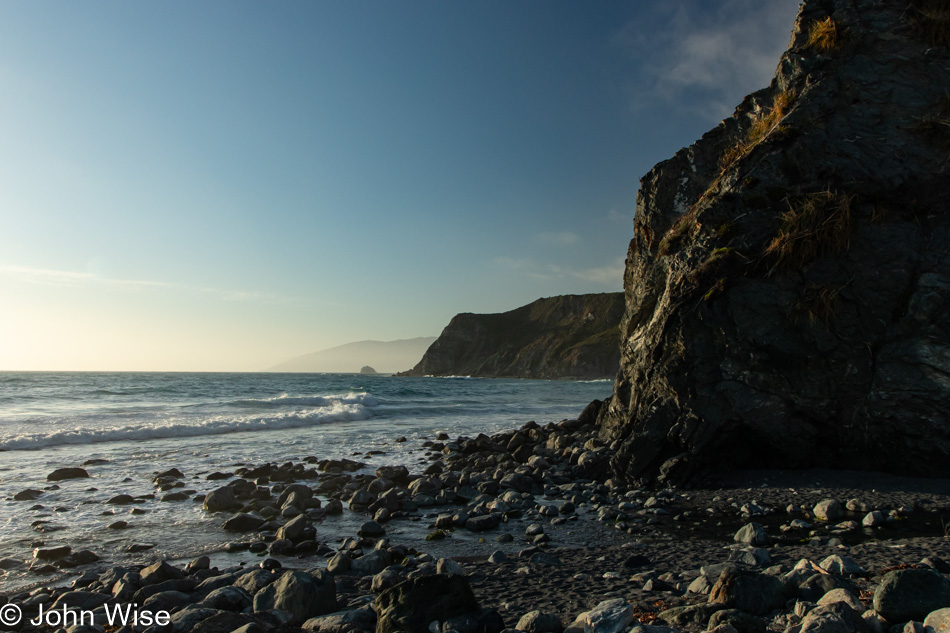
This is the beach from Willow Creek Vista Point and our last stop before returning to our second night in our Nest.
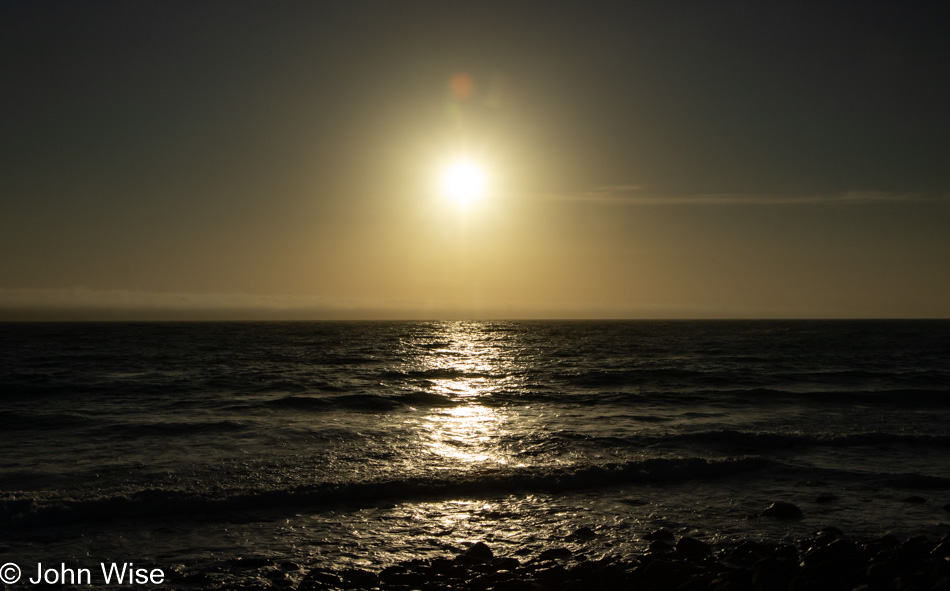
Also, Willow Creek Vista Point and the image I referenced above that was my conundrum.

Should you, too, find yourself with a loony bird, then you too will understand why so many photos of her smiling from your nest are important. You should have heard her mating song that lured me up there.
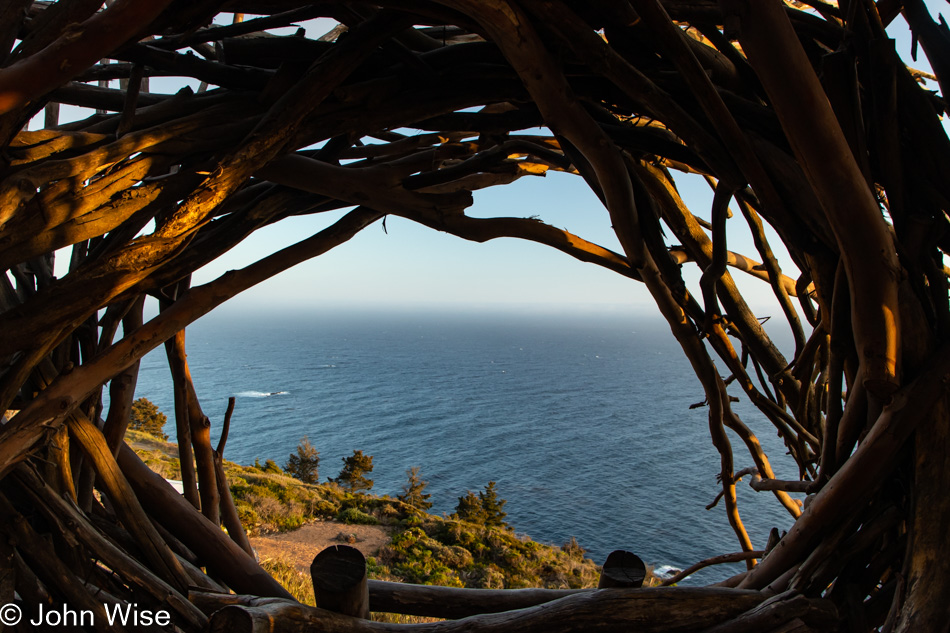
This is why we pay such a premium to spend a couple of nights in a drafty oceanside perch high up a cliff. The view is from our bed.
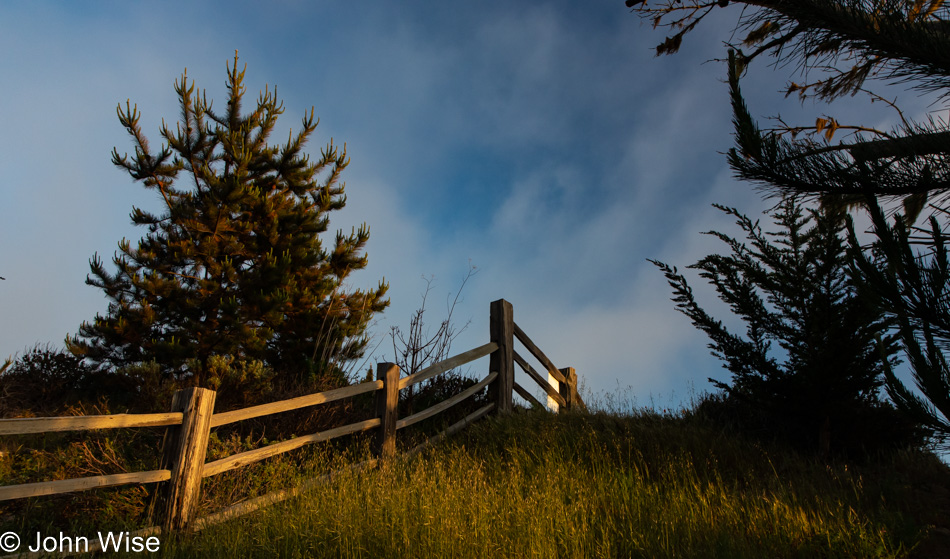
In order to maximize our memories, I need all the views of the approach to our Nest.
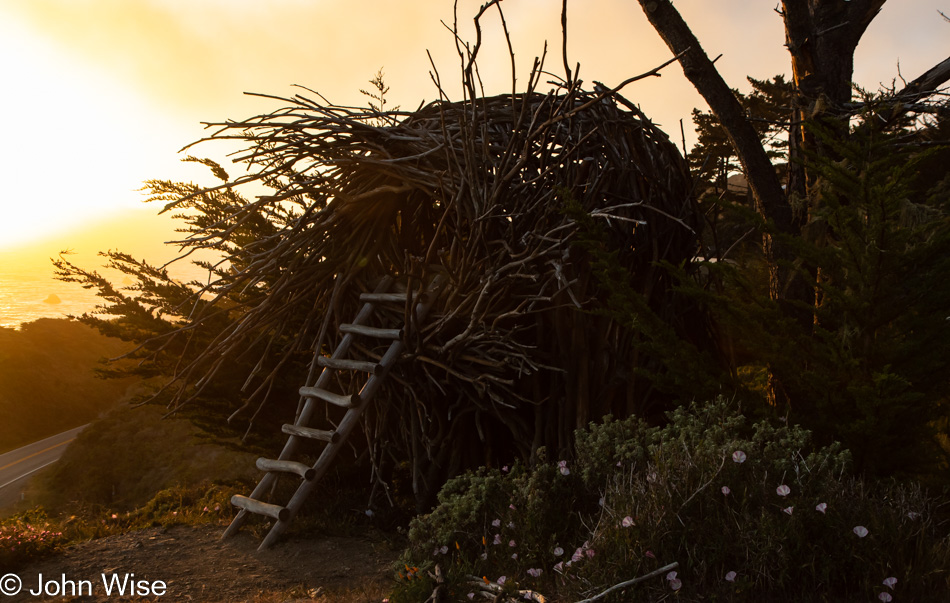
Not an easy location to take photos of as the sun sets; a drone would have come in handy, although drones are not allowed in the resort.
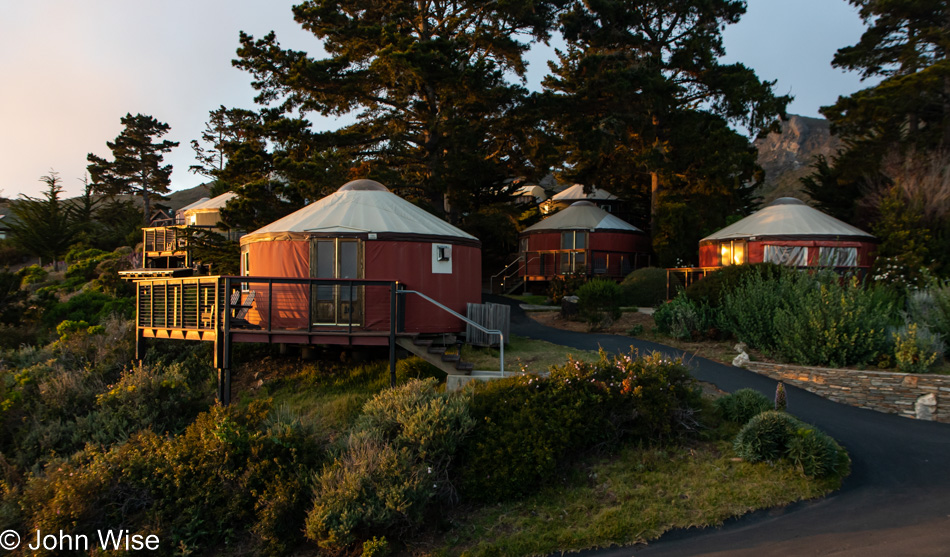
These are the yurts and probably the primary attractions of Treebones Resort, though the Twig House, Tree House, and now the Autonomous Tents are all very attractive, too.
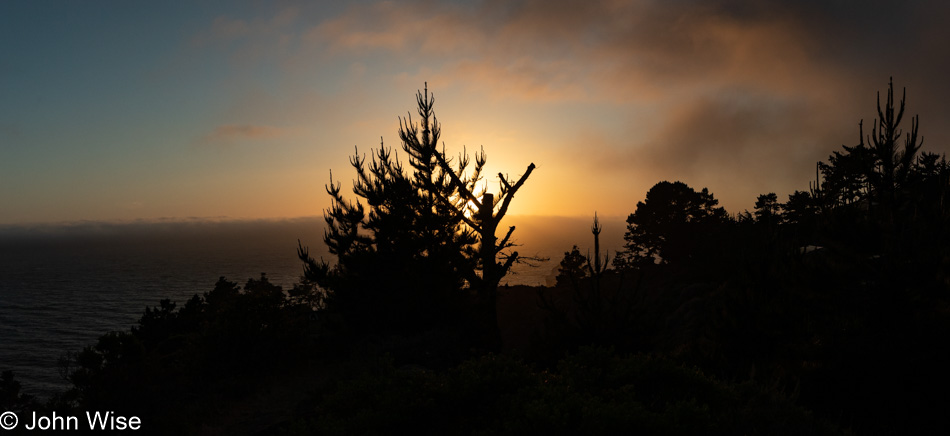
The fog is again trying to move in, and a breeze is kicking up, too, but nothing can dampen our enthusiasm because we have once again experienced a perfect day.

Last-minute addition: after we left the dining area, we heard this really loud frog croaking near a water feature, so we had to investigate if we might see this giant. It had to be big because of the booming sounds it was making. We spotted this guy on the side of the wooden pool, and he was tiny, like about 2 inches or 5 cm, but it was loud, like we couldn’t believe.
